Paul van Yperen's Blog, page 449
July 28, 2013
Al Bano
Italian pop singer Al Bano (1943) is also known as an opera tenor, as an actor and as a winemaker. For about 30 years, he formed Italy`s most popular singing duo with his ex-wife, Romina Power. They performed twice at the Eurovision Song Contest and numerous times at the Sanremo Music Festival.
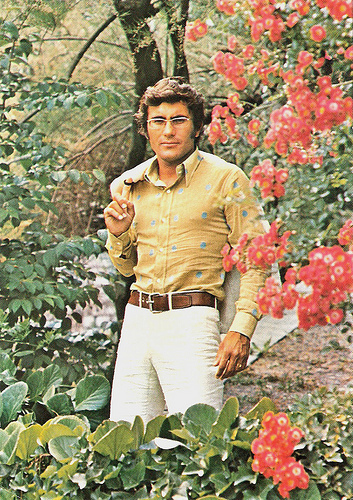
Italian postcard by Grafiche Biondetti (GB), Verona, no. 54.
Romina Power
Al Bano was born Albano Carrisi in the town of Cellino San Marco in Southern Italy in 1943.His mother Iolanda Ottino named him Albano because, when he was born, his father Carmelo Carrisi was fighting in Albania for the Royal Italian Army during World War II. He has one brother, Franco Carrisi (Kocis). Al Bano made his debut as a singer in 1966, at the Festival delle Rose. Two years later, he won at the Disco per l'Estate song competition, with Pensando a te in 1968. He recorded some major hits such as La siepe and Nel sole at that time. Nel sole sold 600,000 copies in Italy within three months of release, and eventually over one million copies, and was awarded a gold disc in July 1968. During that time he also started a musical collaboration with Romina Power, the daughter of the film stars Tyrone Power and Linda Christian. Al Bano had met Romina Power during the production of the Musicarello (Italian teen musical) Nel sole/The World's Gold (Aldo Grimaldi, 1967), named after his hit song. They also co-starred in Pensando a te/Thinking of you (Aldo Grimaldi, 1969), Il suo nome è Donna Rosa/Her name is Donna Rosa (Ettore Maria Fizzarotti, 1969) and Mezzanotte d'amore/Midnight Love (Ettore Maria Fizzarotti, 1970). In total, the couple shot seven films, based on their songs, between 1967 and 1983. They married in 1970 and recorded the duet album Storia di due innamorati (1970). They sang as the duo Al Bano & Romina Power for almost thirty years; their work has been especially popular in Italy, Austria, France, Spain, Romania and Germany. In 1975, the couple released their first album as a duo, Dialogo, which was followed by numerous others. Many of them were also released in Spanish versions. In 1976, they took part in the Eurovision Song Contest with the song We'll Live It All Again. In 1982, the duo broke an Italian record with four songs on the Italian hit parade at the same time. The same year, they participated in the Sanremo Music Festival with the song Felicità and finished second. The song became widely popular, over 6 million copies of the single were sold and in 1985 they received a German Golden Globe for it. In 1983, they made their final Musicarello together, Champagne in paradiso (Aldo Grimaldi, 1983), with Edmund Purdom and written by Al Bano They won first prize in the Sanremo Music Festival 1984 singing Ci sarà and again took part in the Eurovision Song Contest 1985 with Magic Oh Magic. Both their Eurovision entries placed 7th. Other hits include: Nostalgia canaglia (awarded 3rd prize at Festival di Sanremo 1987), Libertà (1987) and Cara Terra mia (third at the Sanremo Music Festival).
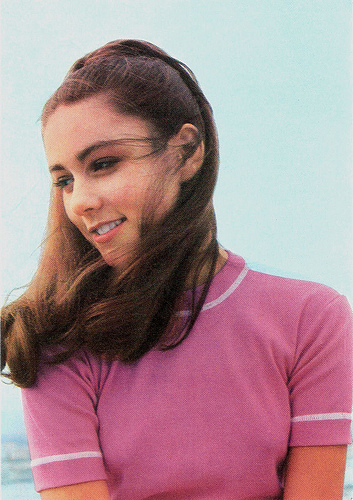
Romina Power. Italian postcard. Photo: RCA.
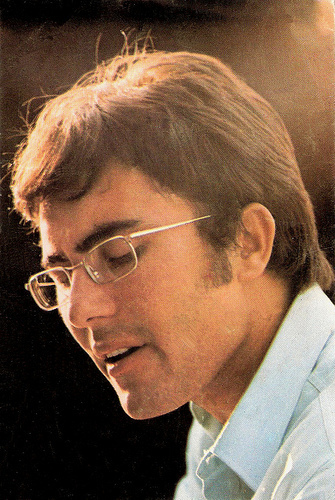
Italian promotion card by EMI / Grafica Galiati, Milano. Photo: EMI.
Passion For Opera
In 1991, Al Bano and Romina Power again participated in the Sanremo Music Festival, this time with the song Oggi sposi. In the same year, they celebrated 25 years of their joint artistic careers with an anthology which included their most popular songs, Le più belle canzoni (in Italy) and Vincerai – Their Greatest Hits (in Europe). They also wrote their autobiography and released a video, both entitled Autoritratto dalla A alla R. After their daughter Ylenia Carrisi disappeared in January 1994 in New Orleans, Al Bano and Romina cancelled all of their concerts and dedicated all their time to the search for their daughter. Police efforts yielded no results. Al Bano returned to his solo career in 1996 with the pop song È la mia vita. Besides for pop music, he has a great passion for opera. During, his career, he has released several opera albums as a tenor. In 1997 he recorded the album Concerto Classico, which went double platinum in a short time. He also performed in place of Luciano Pavarotti alongside two other renowned tenors Plácido Domingo and José Carreras. In 1997, he played in the music video of Herşeye Rağmen (Nonetheless), by Turkish singer Sima (Sima Sarıkaya). His pop hit È la mia vita was followed by Verso il sole (1997) and Ancora in volo (1999). In 1999, Al Bano announced the separation of Romina and him in an open letter to the weekly magazine Oggi. He explained reasons for their break-up, related to the disappearance of their eldest. In 2000, Al Bano returned to the Eurovision stage, providing backing vocals for the Swiss entry (performed in Italian) La vita cos'è? by Jane Bogaert. This song placed 20th out of 24. On 16 October 2001, Carrisi was nominated Goodwill Ambassador of the Food and Agriculture Organization of the United Nations (FAO). In 2005, he starred in the Italian reality show L'isola dei Famosi (Italian version of Celebrity Survivor) with his daughter, Romina Carrisi. It introduced him to a new generation of fans. Al Bano returned to Sanremo in 2007, where he sang Nel perdono which came in second place. He still tours all over the world. He is a constant on Italian television and has a large number of fans who follow his career very closely. To date Al Bano has sold 165 million albums around the world. Al Bano and Romina Power have a son, Yari Marco (1973), and three daughters Ylenia Maria (1970), Cristel Chiara (1985) (starred in the Reality TV show La Fattoria, an Italian version of The Farm) and Romina Iolanda (1987). He has one daughter and one son from ex-girlfriend and journalist Loredana Lecciso, Jasmine Caterina (2001) and Albano Giovanni (2002). He still lives in his birthplace, Cellino San Marco. And about his ‘nameplace’: he has visited Albania a number of times. Al Bano was there for a concert in 1989 and has been enjoying great popularity there.
Al Bano e Romina Power sing Ci Sara' at Sanremo in 1984. Source: Seradimusica (YouTube).
Al Bano & Romina Power sing Felicita (New Version). Source: Dimitar Gunchev (YouTube).
Al Bano sings Tu Per Sempre. Source: ROssOnera (YouTube).
Sources: Evan C. Gutierrez (AllMusic), Al Bano Carrisi Official Web Site, Wikipedia and

Italian postcard by Grafiche Biondetti (GB), Verona, no. 54.
Romina Power
Al Bano was born Albano Carrisi in the town of Cellino San Marco in Southern Italy in 1943.His mother Iolanda Ottino named him Albano because, when he was born, his father Carmelo Carrisi was fighting in Albania for the Royal Italian Army during World War II. He has one brother, Franco Carrisi (Kocis). Al Bano made his debut as a singer in 1966, at the Festival delle Rose. Two years later, he won at the Disco per l'Estate song competition, with Pensando a te in 1968. He recorded some major hits such as La siepe and Nel sole at that time. Nel sole sold 600,000 copies in Italy within three months of release, and eventually over one million copies, and was awarded a gold disc in July 1968. During that time he also started a musical collaboration with Romina Power, the daughter of the film stars Tyrone Power and Linda Christian. Al Bano had met Romina Power during the production of the Musicarello (Italian teen musical) Nel sole/The World's Gold (Aldo Grimaldi, 1967), named after his hit song. They also co-starred in Pensando a te/Thinking of you (Aldo Grimaldi, 1969), Il suo nome è Donna Rosa/Her name is Donna Rosa (Ettore Maria Fizzarotti, 1969) and Mezzanotte d'amore/Midnight Love (Ettore Maria Fizzarotti, 1970). In total, the couple shot seven films, based on their songs, between 1967 and 1983. They married in 1970 and recorded the duet album Storia di due innamorati (1970). They sang as the duo Al Bano & Romina Power for almost thirty years; their work has been especially popular in Italy, Austria, France, Spain, Romania and Germany. In 1975, the couple released their first album as a duo, Dialogo, which was followed by numerous others. Many of them were also released in Spanish versions. In 1976, they took part in the Eurovision Song Contest with the song We'll Live It All Again. In 1982, the duo broke an Italian record with four songs on the Italian hit parade at the same time. The same year, they participated in the Sanremo Music Festival with the song Felicità and finished second. The song became widely popular, over 6 million copies of the single were sold and in 1985 they received a German Golden Globe for it. In 1983, they made their final Musicarello together, Champagne in paradiso (Aldo Grimaldi, 1983), with Edmund Purdom and written by Al Bano They won first prize in the Sanremo Music Festival 1984 singing Ci sarà and again took part in the Eurovision Song Contest 1985 with Magic Oh Magic. Both their Eurovision entries placed 7th. Other hits include: Nostalgia canaglia (awarded 3rd prize at Festival di Sanremo 1987), Libertà (1987) and Cara Terra mia (third at the Sanremo Music Festival).

Romina Power. Italian postcard. Photo: RCA.

Italian promotion card by EMI / Grafica Galiati, Milano. Photo: EMI.
Passion For Opera
In 1991, Al Bano and Romina Power again participated in the Sanremo Music Festival, this time with the song Oggi sposi. In the same year, they celebrated 25 years of their joint artistic careers with an anthology which included their most popular songs, Le più belle canzoni (in Italy) and Vincerai – Their Greatest Hits (in Europe). They also wrote their autobiography and released a video, both entitled Autoritratto dalla A alla R. After their daughter Ylenia Carrisi disappeared in January 1994 in New Orleans, Al Bano and Romina cancelled all of their concerts and dedicated all their time to the search for their daughter. Police efforts yielded no results. Al Bano returned to his solo career in 1996 with the pop song È la mia vita. Besides for pop music, he has a great passion for opera. During, his career, he has released several opera albums as a tenor. In 1997 he recorded the album Concerto Classico, which went double platinum in a short time. He also performed in place of Luciano Pavarotti alongside two other renowned tenors Plácido Domingo and José Carreras. In 1997, he played in the music video of Herşeye Rağmen (Nonetheless), by Turkish singer Sima (Sima Sarıkaya). His pop hit È la mia vita was followed by Verso il sole (1997) and Ancora in volo (1999). In 1999, Al Bano announced the separation of Romina and him in an open letter to the weekly magazine Oggi. He explained reasons for their break-up, related to the disappearance of their eldest. In 2000, Al Bano returned to the Eurovision stage, providing backing vocals for the Swiss entry (performed in Italian) La vita cos'è? by Jane Bogaert. This song placed 20th out of 24. On 16 October 2001, Carrisi was nominated Goodwill Ambassador of the Food and Agriculture Organization of the United Nations (FAO). In 2005, he starred in the Italian reality show L'isola dei Famosi (Italian version of Celebrity Survivor) with his daughter, Romina Carrisi. It introduced him to a new generation of fans. Al Bano returned to Sanremo in 2007, where he sang Nel perdono which came in second place. He still tours all over the world. He is a constant on Italian television and has a large number of fans who follow his career very closely. To date Al Bano has sold 165 million albums around the world. Al Bano and Romina Power have a son, Yari Marco (1973), and three daughters Ylenia Maria (1970), Cristel Chiara (1985) (starred in the Reality TV show La Fattoria, an Italian version of The Farm) and Romina Iolanda (1987). He has one daughter and one son from ex-girlfriend and journalist Loredana Lecciso, Jasmine Caterina (2001) and Albano Giovanni (2002). He still lives in his birthplace, Cellino San Marco. And about his ‘nameplace’: he has visited Albania a number of times. Al Bano was there for a concert in 1989 and has been enjoying great popularity there.
Al Bano e Romina Power sing Ci Sara' at Sanremo in 1984. Source: Seradimusica (YouTube).
Al Bano & Romina Power sing Felicita (New Version). Source: Dimitar Gunchev (YouTube).
Al Bano sings Tu Per Sempre. Source: ROssOnera (YouTube).
Sources: Evan C. Gutierrez (AllMusic), Al Bano Carrisi Official Web Site, Wikipedia and
Published on July 28, 2013 23:00
July 27, 2013
Maxwell Reed
Tall, dark and handsome Maxwell Reed (1919-1974) was a British actor who was trained at the Rank's ‘charm school’. During the late 1940s, he became a teen idol in Britain, and he would be Joan Collins’ first husband.
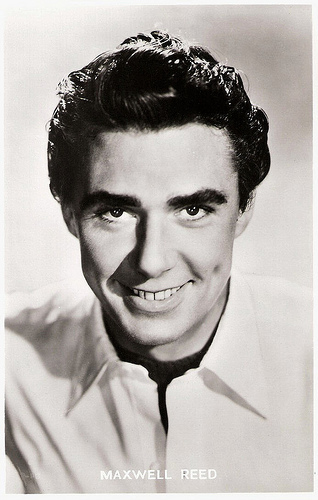
British postcard by A Real Photograph, no. F.S. 53.
Powerful Physical Presence
Maxwell Reed was born in Larne, Northern Ireland in 1919. He worked several years as a merchant seaman, and appeared on stage in Ireland. Then Reed moved to London and was auditioned and signed by the Rank Organisation. He became part of their ‘Company of Youth’ (or 'Charm School'). In 1946 he started his film career with an uncredited part in the British film The Years Between (Compton Bennett, 1946) starring Michael Redgrave. He was 27 at the time. A big part followed in the melodrama The Brothers (David MacDonald, 1947), with Patricia Roc. Dave Pyke at BritMovie : “The Brothers is a good, old fashioned melodrama, enhanced by the wonderful Scottish scenery and a sexy performance from Roc. Reed gives a surprisingly confident performance and works well with Roc. His powerful physical presence is also evident as he strides among the hills and enjoys an epic fist fight with a rival for Roc’s affections.” Reed also played supporting parts in the thriller Dear Murderer (Arthur Crabtree, 1947) featuring Eric Portman, and the crime drama Night Beat (Harold Huth, 1947) starring Anne Crawford. At the time he was the heartthrob of many schoolgirls. Daughter of Darkness (Lance Comfort, 1948) featured Siobhan McKenna as the UK’s first onscreen female serial killer, Emily Beaudine. Reed played her first victim. His second film of 1948 is Daybreak (Compton Bennett, 1948), a dark and gloomy drama which is laden with heavy rain and passion. He had his first lead in Blackout (Robert S. Baker, 1950) as a man suffering from temporary blindness who accidentally walks into a house where a murder has just occurred. Dave Pyke: “Smartly written by John Gilling and smoothly directed by Baker, Blackout is almost like a dry run for The Saint, with Reed portraying Pelly as a wise cracking charmer with a nose for trouble. It is an extremely likeable performance and Reed looks fabulous, it’s just a shame he didn’t get more roles of this type.”
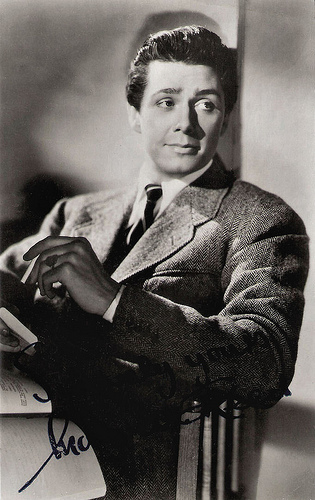
British autograph card.
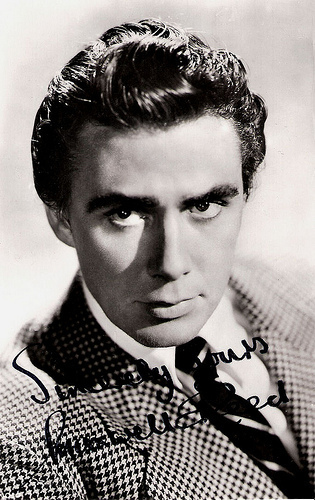
British autograph card.
The Wild Man of British Cinema
Maxwell Reed rotated between leads in B films and supporting roles in major productions. He became known as a ‘hellraiser’ and was dubbed ‘The Wild Man of British Cinema’ by the newspapers. Unclear is why. On screen, he was excellent as a killer in The Dark Man (Jeffrey Dell, 1951). He played a motorcycle daredevil in There Is Another Sun (Lewis Gilbert, 1951) and a boxer in The Square Ring (Basil Dearden, Michael Relph, 1953). He hoped he could repeat the recent Hollywood success of Stewart Granger in Universal’s swashbuckling romance The Flame of Araby (Charles Lamont, 1951) but the film was not a success. In 1952, he married Joan Collins whose first husband he was. The marriage ended in divorce in 1956 and in her 1978 autobiography Past Imperfect, Collins claimed that the divorce was a result of Reed's alleged attempt to sell her to an Arab sheik. Reed’s family strongly objected to Collins’ accusations and managed to get her to withdraw some of them from later editions of the book. In Italy Reed played in the epic Helen of Troy (Robert Wise, 1956) featuring Rossana Podestà, and then drifted to the US. There he was a guest star on many TV shows such as Bonanza (1961), Perry Mason (1964) and Daniel Boone (1966). He also appeared incidentally in films, including The Notorious Landlady (Richard Quine, 1962) with Kim Novak, and the horror film Picture Mommy Dead (Bert I. Gordon, 1966). His last screen role was in the British TV series Sherlock Holmes (1968) with Peter Cushing. In 1974, Maxwell Reed died from cancer, aged 55.
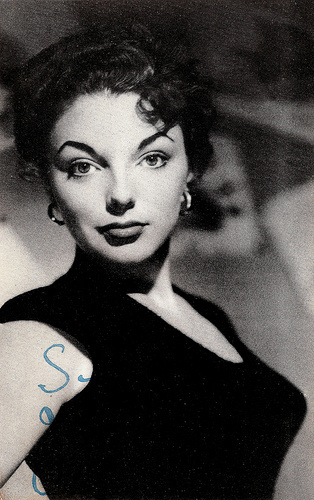
Joan Collins. British postcard by L.D. LTD., London in the Film Star Autograph Portrait Series, no. 60. Photo: J. Arthur Rank Organisation.
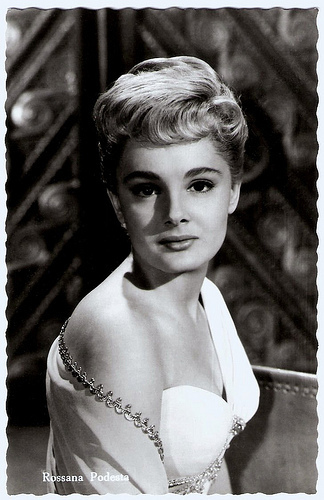
Rossana Podestà. Dutch postcard by Editions P.I., no. 662. Publicity still for Helen of Troy (1956).
Sources: Dave Pyke (BritMovie), Wikipedia, and

British postcard by A Real Photograph, no. F.S. 53.
Powerful Physical Presence
Maxwell Reed was born in Larne, Northern Ireland in 1919. He worked several years as a merchant seaman, and appeared on stage in Ireland. Then Reed moved to London and was auditioned and signed by the Rank Organisation. He became part of their ‘Company of Youth’ (or 'Charm School'). In 1946 he started his film career with an uncredited part in the British film The Years Between (Compton Bennett, 1946) starring Michael Redgrave. He was 27 at the time. A big part followed in the melodrama The Brothers (David MacDonald, 1947), with Patricia Roc. Dave Pyke at BritMovie : “The Brothers is a good, old fashioned melodrama, enhanced by the wonderful Scottish scenery and a sexy performance from Roc. Reed gives a surprisingly confident performance and works well with Roc. His powerful physical presence is also evident as he strides among the hills and enjoys an epic fist fight with a rival for Roc’s affections.” Reed also played supporting parts in the thriller Dear Murderer (Arthur Crabtree, 1947) featuring Eric Portman, and the crime drama Night Beat (Harold Huth, 1947) starring Anne Crawford. At the time he was the heartthrob of many schoolgirls. Daughter of Darkness (Lance Comfort, 1948) featured Siobhan McKenna as the UK’s first onscreen female serial killer, Emily Beaudine. Reed played her first victim. His second film of 1948 is Daybreak (Compton Bennett, 1948), a dark and gloomy drama which is laden with heavy rain and passion. He had his first lead in Blackout (Robert S. Baker, 1950) as a man suffering from temporary blindness who accidentally walks into a house where a murder has just occurred. Dave Pyke: “Smartly written by John Gilling and smoothly directed by Baker, Blackout is almost like a dry run for The Saint, with Reed portraying Pelly as a wise cracking charmer with a nose for trouble. It is an extremely likeable performance and Reed looks fabulous, it’s just a shame he didn’t get more roles of this type.”

British autograph card.

British autograph card.
The Wild Man of British Cinema
Maxwell Reed rotated between leads in B films and supporting roles in major productions. He became known as a ‘hellraiser’ and was dubbed ‘The Wild Man of British Cinema’ by the newspapers. Unclear is why. On screen, he was excellent as a killer in The Dark Man (Jeffrey Dell, 1951). He played a motorcycle daredevil in There Is Another Sun (Lewis Gilbert, 1951) and a boxer in The Square Ring (Basil Dearden, Michael Relph, 1953). He hoped he could repeat the recent Hollywood success of Stewart Granger in Universal’s swashbuckling romance The Flame of Araby (Charles Lamont, 1951) but the film was not a success. In 1952, he married Joan Collins whose first husband he was. The marriage ended in divorce in 1956 and in her 1978 autobiography Past Imperfect, Collins claimed that the divorce was a result of Reed's alleged attempt to sell her to an Arab sheik. Reed’s family strongly objected to Collins’ accusations and managed to get her to withdraw some of them from later editions of the book. In Italy Reed played in the epic Helen of Troy (Robert Wise, 1956) featuring Rossana Podestà, and then drifted to the US. There he was a guest star on many TV shows such as Bonanza (1961), Perry Mason (1964) and Daniel Boone (1966). He also appeared incidentally in films, including The Notorious Landlady (Richard Quine, 1962) with Kim Novak, and the horror film Picture Mommy Dead (Bert I. Gordon, 1966). His last screen role was in the British TV series Sherlock Holmes (1968) with Peter Cushing. In 1974, Maxwell Reed died from cancer, aged 55.

Joan Collins. British postcard by L.D. LTD., London in the Film Star Autograph Portrait Series, no. 60. Photo: J. Arthur Rank Organisation.

Rossana Podestà. Dutch postcard by Editions P.I., no. 662. Publicity still for Helen of Troy (1956).
Sources: Dave Pyke (BritMovie), Wikipedia, and
Published on July 27, 2013 23:00
July 26, 2013
Odile Versois
Delicately beautiful French actress Odile Versois (1930-1980) was the older sister of Marina Vlady. She appeared in some 50 European film and television productions between 1948 and 1980.
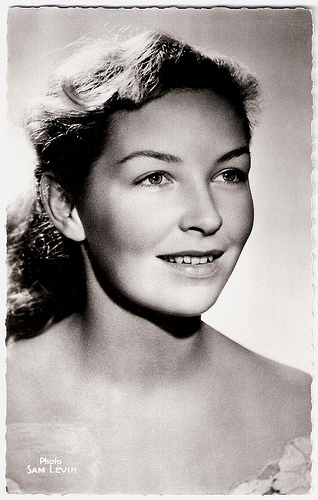
French postcard by Editions du Globe, Paris, no. 138. Photo: Sam Lévin.
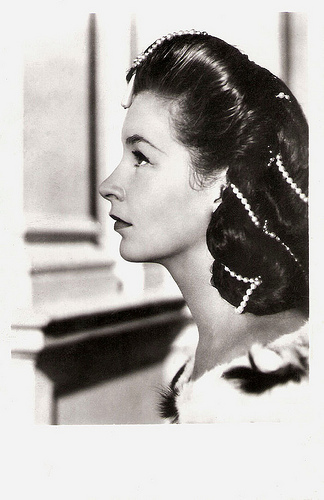
French postcard by Noyer, no. 1296.
Petit Rat
Odile Versois was born Etiennette (according to some sources Tatiana or Katiana) De Poliakoff-Baidarov in Paris in 1930. Her father was Russian-born opera singer Vladimir de Poliakoff and her mother ballerina Militza Evgueïevna de Poliakoff née Envold. She was the second of four Poliakoff sisters, all of whom became renown actresses in their own right: Marina Vlady, Hélène Vallier and Olga Baïdar-Poliakoff. Like her siblings, she started acting at a young age, but she began her career as a ‘petit rat’ (child ballerina) with the Corps de Ballet of the Opéra de Paris under the name of Tania Baydarova. At the age of 18, she subsequently turned to film acting. She proved a natural with a major debut in Les dernières vacances/The Last Vacation (Roger Leenhardt, 1948). Set in the sunny south of France, this devilish drama chronicles the romantic entanglements between two vacationing families. For her role she was awarded with the Prix Suzanne-Bianchetti for the best young actress. She then did an audition for An American in Paris (Vincente Minnelli, 1951), but her long-time friend Leslie Caron obtained the role. During a vacation in England Versois was hired to play a role in the British film Into the Blue (Herbert Wilcox, 1951) opposite Michael Wilding. In the following decade the serene, light-haired Versois continued to provide charm to such British films as A Day to Remember (Ralph Thomas, 1953), Chance Meeting/ Young Lovers (Anthony Asquith, 1954), the comedy To Paris with Love (Robert Hamer, 1955) with Alec Guinness, Checkpoint (Richard Thomas, 1956), and the dark action thriller Room 43/Passport to Shame (Alvin Rakoff, 1958) starring Eddie Constantine, Diana Dors and Herbert Lom. But she also undertook leading lady parts in several Italian, German and French films. Hal Erickson at AllMovie mentions her role as 13th century Francesca de Rimini in Paolo e Francesca/Paolo and Francesca (Raffaello Matarazzo, 1953) as “one of her more flamboyant assignments”. At IMDb , Gary Brumburgh writes that “she moved audiences most with her portrayals of fragile, often tragic heroines in romantic dramas” such as Bel amour/Beautiful Love (Francois Campaux, 1951), Domenica (Maurice Cloche, 1952), Grand gala (Francois Campaux, 1952) and Herscher ohne Krone/King in Shadow (Harald Braun, 1958) starring Horst Buchholz. In the successful suspense melodrama Toi, le venin/Nude in a White Car (Robert Hossein, 1958), she co-starred with director-writer Hossein and her sister Marina Vlady - known for her sultry roles.
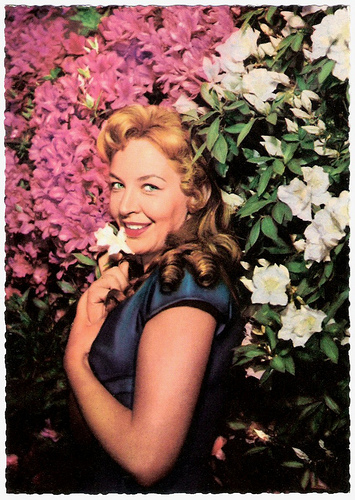
German postcard by ISV, no. D 6. Photo: Farabola.
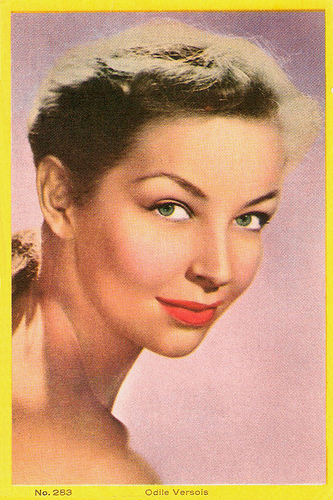
Mexican Collectors card, no. 283.
An Ultimate and Moving Appearance
In the 1960s Odile Versois matured in crime dramas and lively costume films, notably in the murder mystery Le rendez-vous (Jean Delannoy, 1961) starring George Sanders, the swashbuckler Cartouche/Swords of Blood (Philippe de Broca, 1962) starring Jean-Paul Belmondo as a 18th century French bandit chief, and the erotic period piece Benjamin (Michel Deville, 1968) featuring Pierre Clémenti. She also worked on the French, Belgian, Swiss and North African stages. Dogged by ill health, she was seen less frequently into the 1970s. On television, she lend some touching performances, particularly in the British mini-series A Place in the Sun (1972), the family drama Églantine (Jean-Claude Brialy, 1972) and Le confessional des penitents noirs (Alain Boudet, 1977). Her last film was Le Crabe-Tambour/The Crab Drum (Pierre Schoendoerffer, 1977) starring Jacques Perrin. This portrait of an eccentric but courageous warrior involved in the Indochinese and Algerian wars, won several French film industry awards. French magazine Première called her performance “une ultime et émouvante apparition” (an ultimate and moving appearance). Versois was married and divorced twice. First to actor Jacques Dacqmine, and in 1953 to Count François Pozzo di Borgo, with whom she had four children: Barbara (1954), Charles-André (1955), Alexandre (1957) and Vanina (1964). Her last role was in an episode of the French TV series Julien Fontanes, magistrate (Guy-André Lefranc, 1980) starring Jacques Morel. In 1980, Odile Versois passed away of cancer in Neuilly-sur-Seine, a week after her 50th birthday. Gary Brumburgh ends his bio at IMDb thus: “a gentle, beautiful soul [had] gone before her time”.
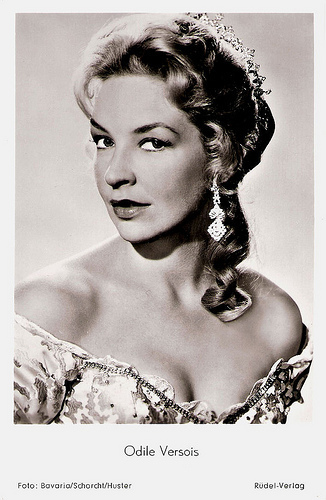
German postcard by Rüdel-Verlag, Hamburg-Bergedorf, no. 1862. Photo: Huster / Bavaria / Schorchtfilm. Publicity still for Herrscher ohne Krone/King in Shadow (Harald Braun, 1957).
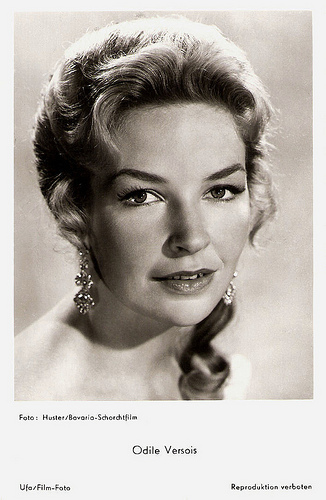
German postcard by Ufa/Film-Foto, Berlin-Tempelhof, no. FL 3374. Retail price: 25 Pfg. Photo: Huster / Bavaria-Schorchtfilm. Publicity still for Herrscher ohne Krone/King in Shadow (Harald Braun, 1957).
Sources: Hal Erickson (AllMovie),

French postcard by Editions du Globe, Paris, no. 138. Photo: Sam Lévin.

French postcard by Noyer, no. 1296.
Petit Rat
Odile Versois was born Etiennette (according to some sources Tatiana or Katiana) De Poliakoff-Baidarov in Paris in 1930. Her father was Russian-born opera singer Vladimir de Poliakoff and her mother ballerina Militza Evgueïevna de Poliakoff née Envold. She was the second of four Poliakoff sisters, all of whom became renown actresses in their own right: Marina Vlady, Hélène Vallier and Olga Baïdar-Poliakoff. Like her siblings, she started acting at a young age, but she began her career as a ‘petit rat’ (child ballerina) with the Corps de Ballet of the Opéra de Paris under the name of Tania Baydarova. At the age of 18, she subsequently turned to film acting. She proved a natural with a major debut in Les dernières vacances/The Last Vacation (Roger Leenhardt, 1948). Set in the sunny south of France, this devilish drama chronicles the romantic entanglements between two vacationing families. For her role she was awarded with the Prix Suzanne-Bianchetti for the best young actress. She then did an audition for An American in Paris (Vincente Minnelli, 1951), but her long-time friend Leslie Caron obtained the role. During a vacation in England Versois was hired to play a role in the British film Into the Blue (Herbert Wilcox, 1951) opposite Michael Wilding. In the following decade the serene, light-haired Versois continued to provide charm to such British films as A Day to Remember (Ralph Thomas, 1953), Chance Meeting/ Young Lovers (Anthony Asquith, 1954), the comedy To Paris with Love (Robert Hamer, 1955) with Alec Guinness, Checkpoint (Richard Thomas, 1956), and the dark action thriller Room 43/Passport to Shame (Alvin Rakoff, 1958) starring Eddie Constantine, Diana Dors and Herbert Lom. But she also undertook leading lady parts in several Italian, German and French films. Hal Erickson at AllMovie mentions her role as 13th century Francesca de Rimini in Paolo e Francesca/Paolo and Francesca (Raffaello Matarazzo, 1953) as “one of her more flamboyant assignments”. At IMDb , Gary Brumburgh writes that “she moved audiences most with her portrayals of fragile, often tragic heroines in romantic dramas” such as Bel amour/Beautiful Love (Francois Campaux, 1951), Domenica (Maurice Cloche, 1952), Grand gala (Francois Campaux, 1952) and Herscher ohne Krone/King in Shadow (Harald Braun, 1958) starring Horst Buchholz. In the successful suspense melodrama Toi, le venin/Nude in a White Car (Robert Hossein, 1958), she co-starred with director-writer Hossein and her sister Marina Vlady - known for her sultry roles.

German postcard by ISV, no. D 6. Photo: Farabola.

Mexican Collectors card, no. 283.
An Ultimate and Moving Appearance
In the 1960s Odile Versois matured in crime dramas and lively costume films, notably in the murder mystery Le rendez-vous (Jean Delannoy, 1961) starring George Sanders, the swashbuckler Cartouche/Swords of Blood (Philippe de Broca, 1962) starring Jean-Paul Belmondo as a 18th century French bandit chief, and the erotic period piece Benjamin (Michel Deville, 1968) featuring Pierre Clémenti. She also worked on the French, Belgian, Swiss and North African stages. Dogged by ill health, she was seen less frequently into the 1970s. On television, she lend some touching performances, particularly in the British mini-series A Place in the Sun (1972), the family drama Églantine (Jean-Claude Brialy, 1972) and Le confessional des penitents noirs (Alain Boudet, 1977). Her last film was Le Crabe-Tambour/The Crab Drum (Pierre Schoendoerffer, 1977) starring Jacques Perrin. This portrait of an eccentric but courageous warrior involved in the Indochinese and Algerian wars, won several French film industry awards. French magazine Première called her performance “une ultime et émouvante apparition” (an ultimate and moving appearance). Versois was married and divorced twice. First to actor Jacques Dacqmine, and in 1953 to Count François Pozzo di Borgo, with whom she had four children: Barbara (1954), Charles-André (1955), Alexandre (1957) and Vanina (1964). Her last role was in an episode of the French TV series Julien Fontanes, magistrate (Guy-André Lefranc, 1980) starring Jacques Morel. In 1980, Odile Versois passed away of cancer in Neuilly-sur-Seine, a week after her 50th birthday. Gary Brumburgh ends his bio at IMDb thus: “a gentle, beautiful soul [had] gone before her time”.

German postcard by Rüdel-Verlag, Hamburg-Bergedorf, no. 1862. Photo: Huster / Bavaria / Schorchtfilm. Publicity still for Herrscher ohne Krone/King in Shadow (Harald Braun, 1957).

German postcard by Ufa/Film-Foto, Berlin-Tempelhof, no. FL 3374. Retail price: 25 Pfg. Photo: Huster / Bavaria-Schorchtfilm. Publicity still for Herrscher ohne Krone/King in Shadow (Harald Braun, 1957).
Sources: Hal Erickson (AllMovie),
Published on July 26, 2013 23:00
July 25, 2013
Bernadette Lafont (1938-2013)
French actress Bernadette Lafont (1938-2013) died Thursday aged 74. She appeared in several classics of the Nouvelle Vague. Original and full of contradictions, she was both sexy and rather plain, brassy and quite serious, a mixture of intellect, sensuality and humour.

French postcard by Editions P.I., Paris, no. 1076, offered by Les Carbones Kores 'Carboplane'. Photo: Noa.
The Right Place at the Right Time
Bernadette Paule Anne Lafont was born in in Nîmes in the South of France in 1938. She was the daughter of a pharmacist and his wife. As a teenager, she started her career as a dancer. She entered the Opéra de Nîmes where she fell in love with her future husband, the handsome actor Gérard Blain.
In Paris she met the young critic and aspiring film director François Truffaut, who offered her a role in his second short film, shot in Nîmes. So she made her screen debut in Les Mistons/The Mischief Makers (Francois Truffaut, 1957) opposite Gérard Blain. It was a comedy about five kids, who spy on two lovers during a hot summer day. It turned out to be that she was in the right place at the right time to catch the Nouvelle Vague movement, the new wave of filmmakers that would revolutionize the cinema.
She starred particularly in films by Truffaut and by Claude Chabrol. Her first feature and still one of her best-known films is Le Beau Serge/Bitter Reunion (Claude Chabrol, 1958) with Gérard Blain and Jean-Claude Brialy. (She had married Blain the year before but they would divorce a year later.) Many Nouvelle Vague films followed.
With Chabrol she also made À double tour/Leda (Claude Chabrol, 1959) starring Madeleine Robinson, Les bonnes femmes/The Good Time Girls (Claude Chabrol, 1960) with Stéphane Audran, and Les godelureaux/Wise Guys (Claude Chabrol, 1961). She appeared in Truffaut’s comedy Tire-au-flanc 62/The Army Game (Claude de Givray, François Truffaut, 1960), and was the feisty heroine of Truffaut’s Une belle fille comme moi/A Gorgeous Bird Like Me (François Truffaut, 1972).
For Louis Malle she did a supporting part in his comedy Le voleur/The Thief of Paris (Louis Malle, 1967) starring Jean-Paul Belmondo, and for Jacques Rivette she joined the cast of Out 1, noli me tangere/Out 1 (Jacques Rivette, Suzanne Schiffman, 1971) and Out 1: Spectre (Jacques Rivette, 1974). Finally, she played the role of Marie, one third of the trio of lovers in La Maman et la Putain/The Mother and the Whore (Jean Eustache, 1973), considered by some critics as the last film of the Nouvelle Vague.
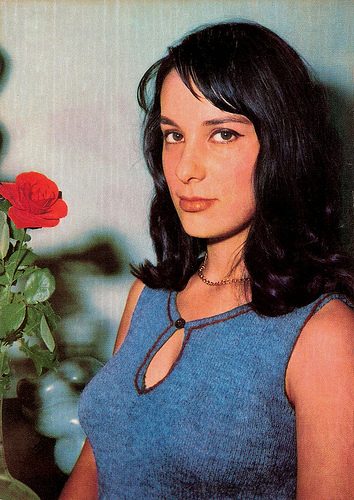
French postcard by Editions Borde, Paris, no. 124. Photo: Morel.
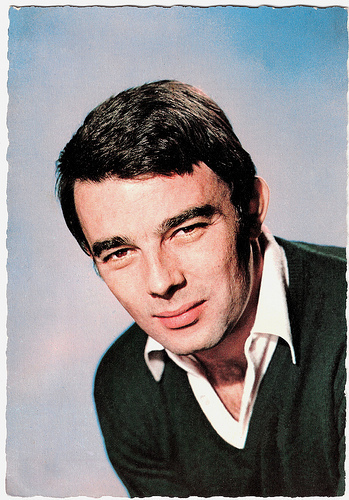
Gérard Blain. French postcard by E.D.U.G., no. 62. Photo: Sam Lévin.
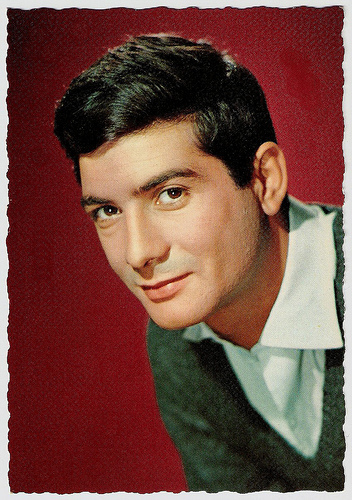
Jean-Claude Brialy. French postcard by E.D.U.G., nr. 67. Photo: Sam Lévin.
Always A Strong Presence
A well-known film with Bernadette Lafont is La Fiancée du Pirate/A Very Curious Girl (Nelly Kaplan, 1969). The success of this film about violence against women renewed her career after a difficult period. She was seen in Les stances à Sophie/Sophie’s Ways (Moshé Mizrahi, 1971), the crime drama Zig Zig (László Szabó, 1975) with Catherine Deneuve, and had a small part as the cellmate of Isabelle Huppert in Violette Nozière (Claude Chabrol, 1978).
In Italy she appeared in the comedy Il Ladrone/The Thief (Pasquale Festa Campanile, 1980). In a 1997 New York Times article, Katherine Knorr writes: “Lafont has in a tumultuous life done a bit of everything, from television movies to the stage, never quite the megastar but always a strong presence, smart and messed up all at the same time”.
In the 1980s she appeared in Chabrol’s crime films Inspecteur Lavardin/Inspector Lavardin (Claude Chabrol, 1986) featuring Jean Poiret, and Masques/Masks (Claude Chabrol, 1987) with Philippe Noiret. She also played in Les saisons du plaisir/The Pleasure Seasons (1988) and other comedies of Jean-Pierre Mocky.
Lafont won the César Award for Best Actress in a Supporting Role for L'Effrontée/Charlotte and Lulu (Claude Miller, 1985) starring Charlotte Gainsbourg. The energetic Lafont created in 1990 an audio visual workshop to help young actors develop their creativity. She is the co-founder and on the committee that awards the Glace Gervais and an accompanying 100,000 franc prize to works competing in the Cannes Film Festival ‘Un certain Regard’ category. The award was designed to help bolster the budding careers of filmmakers.
Her later films include Généalogies d'un crime/Genealogies of a Crime (Raul Ruiz, 1997) with Catherine Deneuve, and the comedy Ripoux 3/Part-Time Cops (Claude Zidi, 2003) with Philippe Noiret. In May 2007, she chaired the jury for the fifth edition of the Award for Education presented at the 60th Cannes Film Festival.
After her divorce from Blain in 1959, Bernadette Lafont had married the Hungarian sculptor Diourka Medveczky. Although the marriage was difficult and ended in a divorce, there were three children: actress Élisabeth Lafont, David Lafont and the late actress Pauline Lafont, who died in the summer of 1988 under tragic circumstances. She went for a walk near the family property in the Cevennes and never returned. For many weeks, police searched and the popular press went on a feeding frenzy. When Pauline's body was finally found, it became clear she had fallen down in a rough, lonely terrain.
Lafont published her autobiography in 1997, an event heralded by a grand star-studded gala in Paris. For her long service to the French motion picture industry, she was given an Honorary César Award in 2003. She was made Officier de la Légion d'honneur (Officer of the Legion of Honour) in 2009. Bernadette Lafont had been hospitalised in her home town of Nimes on Monday after falling ill and died early Thursday 25 July, the hospital said in a statement.
Trailer for La Fiancée du Pirate/A Very Curious Girl (1969). Source: Fedesartorio (YouTube).
Trailer for Une belle fille comme moi/A Gorgeous Bird Like Me (1972). Source: Heroxmasox (YouTube).
Bernadette Lafont listens to Edith Piaf's Les amants de Paris in La maman et la putain/The Mother and the Whore (1973). Source: Nostalgist (YouTube).
Sources: Katherine Knorr (New York Times), Sandra Brennan (AllMovie), France 24, Wikipedia, and .

French postcard by Editions P.I., Paris, no. 1076, offered by Les Carbones Kores 'Carboplane'. Photo: Noa.
The Right Place at the Right Time
Bernadette Paule Anne Lafont was born in in Nîmes in the South of France in 1938. She was the daughter of a pharmacist and his wife. As a teenager, she started her career as a dancer. She entered the Opéra de Nîmes where she fell in love with her future husband, the handsome actor Gérard Blain.
In Paris she met the young critic and aspiring film director François Truffaut, who offered her a role in his second short film, shot in Nîmes. So she made her screen debut in Les Mistons/The Mischief Makers (Francois Truffaut, 1957) opposite Gérard Blain. It was a comedy about five kids, who spy on two lovers during a hot summer day. It turned out to be that she was in the right place at the right time to catch the Nouvelle Vague movement, the new wave of filmmakers that would revolutionize the cinema.
She starred particularly in films by Truffaut and by Claude Chabrol. Her first feature and still one of her best-known films is Le Beau Serge/Bitter Reunion (Claude Chabrol, 1958) with Gérard Blain and Jean-Claude Brialy. (She had married Blain the year before but they would divorce a year later.) Many Nouvelle Vague films followed.
With Chabrol she also made À double tour/Leda (Claude Chabrol, 1959) starring Madeleine Robinson, Les bonnes femmes/The Good Time Girls (Claude Chabrol, 1960) with Stéphane Audran, and Les godelureaux/Wise Guys (Claude Chabrol, 1961). She appeared in Truffaut’s comedy Tire-au-flanc 62/The Army Game (Claude de Givray, François Truffaut, 1960), and was the feisty heroine of Truffaut’s Une belle fille comme moi/A Gorgeous Bird Like Me (François Truffaut, 1972).
For Louis Malle she did a supporting part in his comedy Le voleur/The Thief of Paris (Louis Malle, 1967) starring Jean-Paul Belmondo, and for Jacques Rivette she joined the cast of Out 1, noli me tangere/Out 1 (Jacques Rivette, Suzanne Schiffman, 1971) and Out 1: Spectre (Jacques Rivette, 1974). Finally, she played the role of Marie, one third of the trio of lovers in La Maman et la Putain/The Mother and the Whore (Jean Eustache, 1973), considered by some critics as the last film of the Nouvelle Vague.

French postcard by Editions Borde, Paris, no. 124. Photo: Morel.

Gérard Blain. French postcard by E.D.U.G., no. 62. Photo: Sam Lévin.

Jean-Claude Brialy. French postcard by E.D.U.G., nr. 67. Photo: Sam Lévin.
Always A Strong Presence
A well-known film with Bernadette Lafont is La Fiancée du Pirate/A Very Curious Girl (Nelly Kaplan, 1969). The success of this film about violence against women renewed her career after a difficult period. She was seen in Les stances à Sophie/Sophie’s Ways (Moshé Mizrahi, 1971), the crime drama Zig Zig (László Szabó, 1975) with Catherine Deneuve, and had a small part as the cellmate of Isabelle Huppert in Violette Nozière (Claude Chabrol, 1978).
In Italy she appeared in the comedy Il Ladrone/The Thief (Pasquale Festa Campanile, 1980). In a 1997 New York Times article, Katherine Knorr writes: “Lafont has in a tumultuous life done a bit of everything, from television movies to the stage, never quite the megastar but always a strong presence, smart and messed up all at the same time”.
In the 1980s she appeared in Chabrol’s crime films Inspecteur Lavardin/Inspector Lavardin (Claude Chabrol, 1986) featuring Jean Poiret, and Masques/Masks (Claude Chabrol, 1987) with Philippe Noiret. She also played in Les saisons du plaisir/The Pleasure Seasons (1988) and other comedies of Jean-Pierre Mocky.
Lafont won the César Award for Best Actress in a Supporting Role for L'Effrontée/Charlotte and Lulu (Claude Miller, 1985) starring Charlotte Gainsbourg. The energetic Lafont created in 1990 an audio visual workshop to help young actors develop their creativity. She is the co-founder and on the committee that awards the Glace Gervais and an accompanying 100,000 franc prize to works competing in the Cannes Film Festival ‘Un certain Regard’ category. The award was designed to help bolster the budding careers of filmmakers.
Her later films include Généalogies d'un crime/Genealogies of a Crime (Raul Ruiz, 1997) with Catherine Deneuve, and the comedy Ripoux 3/Part-Time Cops (Claude Zidi, 2003) with Philippe Noiret. In May 2007, she chaired the jury for the fifth edition of the Award for Education presented at the 60th Cannes Film Festival.
After her divorce from Blain in 1959, Bernadette Lafont had married the Hungarian sculptor Diourka Medveczky. Although the marriage was difficult and ended in a divorce, there were three children: actress Élisabeth Lafont, David Lafont and the late actress Pauline Lafont, who died in the summer of 1988 under tragic circumstances. She went for a walk near the family property in the Cevennes and never returned. For many weeks, police searched and the popular press went on a feeding frenzy. When Pauline's body was finally found, it became clear she had fallen down in a rough, lonely terrain.
Lafont published her autobiography in 1997, an event heralded by a grand star-studded gala in Paris. For her long service to the French motion picture industry, she was given an Honorary César Award in 2003. She was made Officier de la Légion d'honneur (Officer of the Legion of Honour) in 2009. Bernadette Lafont had been hospitalised in her home town of Nimes on Monday after falling ill and died early Thursday 25 July, the hospital said in a statement.
Trailer for La Fiancée du Pirate/A Very Curious Girl (1969). Source: Fedesartorio (YouTube).
Trailer for Une belle fille comme moi/A Gorgeous Bird Like Me (1972). Source: Heroxmasox (YouTube).
Bernadette Lafont listens to Edith Piaf's Les amants de Paris in La maman et la putain/The Mother and the Whore (1973). Source: Nostalgist (YouTube).
Sources: Katherine Knorr (New York Times), Sandra Brennan (AllMovie), France 24, Wikipedia, and .
Published on July 25, 2013 15:30
July 24, 2013
Eleuterio Rodolfi
Eleuterio Rodolfi (1876-1933) was an Italian actor, director and scriptwriter, who was highly active in the Italian silent cinema.
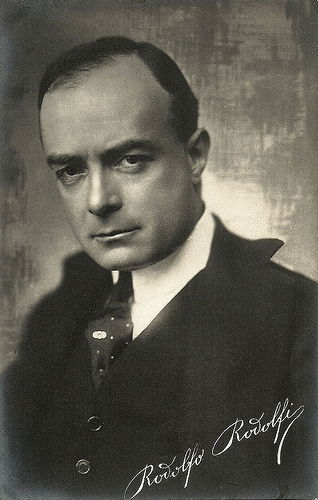
Italian postcard.
Often Hinting At Forbidden Fruits And Voyeurism
Eleuterio Rodolfi aka Rodolfo Rodolfi was born in Bologna in 1876. He was the son of Giuseppe Rodolfi (1827-1885), a famous stage actor in the 19th century. He debuted on stage as 'generico giovane' (generic young actor) with the company of Francesco Garzes. He then moved to other important theatre companies, such as the one of Ermete Novelli. There he met Adele Mosso, who worked as 'seconda donna' (second woman) in the company. They married in 1895. In 1911 he moved over to cinema and was hired by the Ambrosio film company of Turin, where he became both actor and director. For Ambrosio, Rodolfi acted in some 95 films of which some 80 ones were directed and scripted by himself. Many of these were comedies interpreted by Rodolfi together with actress Gigetta Morano, with the two acting and becoming known as ‘Gigetta’ and ‘Rodolfi’. In contrast to the previous anarchist farces by Cretinetti and others focused on speed and havoc, entitled as ‘comiche’ in Italian, the comedies with Gigetta and Rodolfi were true ‘commedie’, so more situational, boulevardier, less speedy, and often hinting at forbidden fruits and voyeurism. In the risqué comedy L'acqua miracolosa/The miraculous water (Eleuterio Rodolfi, 1914) Gigetta’s husband deplores that in their flat he hears children everywhere (the set is built up like a doll’s house) but he cannot get any. The family doctor (Rodolfi) has a secret affair with Gigetta. He advises the wife to go the wondrous wells – where she meets no other than the doctor. In the end everybody is happy: the husband has become father of twins, and the wife lifts a glass in which we see a little doctor. Often in their comedies Morano and Rodolfi played together with a third actor, the portly little bourgeois Camillo De Riso. He frequently played Morano’s father, as in Un successo diplomatico/A diplomatic success (1913) and L’oca alla Colbert/Duck à la Colbert (1913).
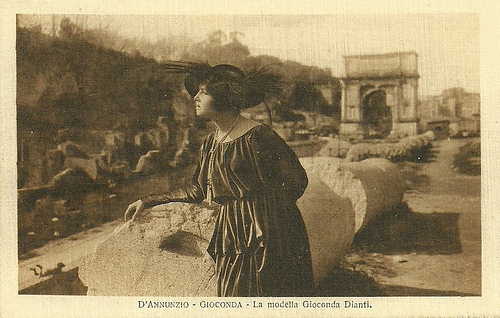
Helena Makowska in La Gioconda (1916). Italian postcard by IPA CT, no. 3654, Censura S. Prefetti, Terni, 18-4-1917. Photo: Ambrosio. Caption: 'The model Gioconda Danti.'
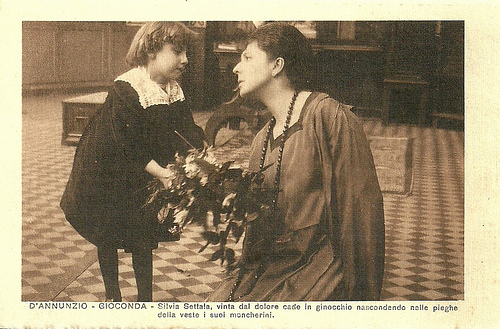
Mercedes Brignone in La Gioconda (1916). Italian postcard by IPA CT, no. 3660, Censura S. Prefetti, Terni, 18-4-1917. Photo: Ambrosio.
The Last Days of Pompeii
Eleuterio Rodolfi also acted in and directed historical films, such as the super-production Gli ultimi giorni di Pompei/The Last Days of Pompeii (Eleuterio Rodolfi, 1913), based on Edward Bulwer-Lytton’s famous novel and a worldwide success. The film starred Fernanda Negri Pouget as the blind girl Nydia, Ubaldo Stefani as Glaucus and Antonio Crisanti as Arbaces. Despite what IMDb writes, Mario Caserini had nothing to do with the film. The Turinese company Pasquali made a competing version at the same time, so competition was fierce. Moreover, in recent times the Ambrosio version is often confused with the later silent version of 1926, directed by Carmine Gallone and Amleto Palermi, and starring Victor Varconi, Maria Corda and Bernhard Goetzke, as Glaucus, Nydia and Arbaces. Among Rodolfi's films in the mid-1910s for Ambrosio were a few with the Polish actress turned Italian diva Elena/ Helena Makowska, such as Eva nemica (Giuseppe Pinto, Eleuterio Rodolfi, 1916), and the D’Annunzio adaptations La Gioconda (Eleuterio Rodolfi, 1916) and Fiaccola sotto il moggio/Light under a bushel (Eleuterio Rodolfi, 1916).
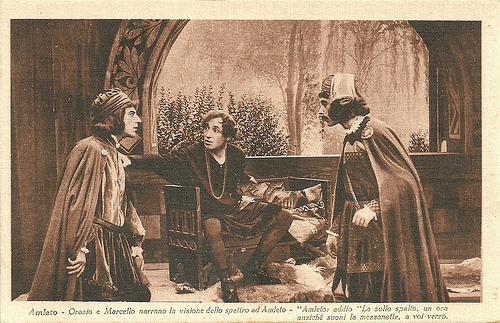
Ruggero Ruggeri in Amleto/Hamlet (1917). Italian postcard. Caption: Horatio and Marcellus tell Hamlet of their vision of the ghost. Hamlet responds (Shakespeare's words): 'Upon the platform, 'twixt eleven and twelve, I'll visit you.'
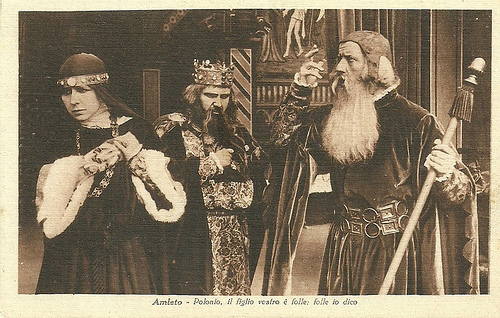
Mercedes Brignone in Amleto/Hamlet (1917). Italian postcard. Caption: Polonius says to Queen Gertrude (Mercedes Brignone) and King Claudius (Armand Pouget): 'Your noble son is mad. Mad call I it' (Shakespeare).
Hamlet
In 1916 Eleuterio Rodolfi also started at Jupiter Film, where he shot some seven dramas – of which just one survives: Ah! Le donne!/Ah! Women! (Eleuterio Rodolfi, 1916), with Rodolfi, Armand Pouget and Mercedes Brignone. In 1917 he founded his own film company Rodolfi Film, with which he made films like the Shakespeare adaptation Amleto/Hamlet (Eleuterio Rodolfi, 1917), starring Ruggero Ruggeri, ‘monstre sacré’ of the Italian Belle Epoque, and also with Elena/ Helena Makowska as Ofelia, Pouget as the King, and Mercedes Brignone as the Queen. In the early 1920s Rodolfi did various films with Mercedes Brignone, Lola Visconti Brignone and Armand Pouget. Rodolfi’s company ceased activity around 1922, after which he did one last production for the Fert Pittaluga company: Maciste e il nipote d’America/Maciste and the grandson of America (Eleuterio Rodolfi, 1924), a film in a completely different genre, and starring Bartolomeo Pagano and Diomira Jacobini, plus Pauline Polaire, Alberto Collo, Oreste Bilancia, and Mercedes Brignone. After that he withdrew from the set and returned to the stage. In the late 1920s he withdrew from the stage as well. The last years of his life Eleuterio Rodolfi spent in the city of a Brescia, where he committed suicide in 1933.
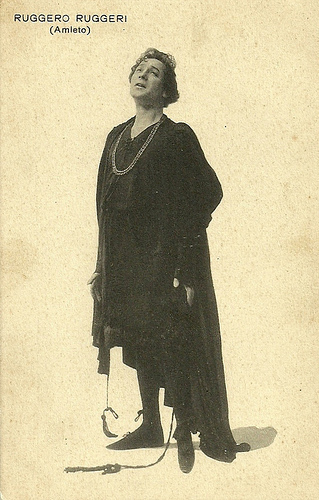
Italian postcard, no. 8067. Photo: Ruggero Ruggeri as Hamlet, either on stage or in the film Amleto/Hamlet (Eleuterio Rodolfi, 1917).
Sources: Aldo Bernardini/Vittorio Martinelli (Il cinema muto italiano), Marianne Lewinsky/Chiara Caranti (Rodolfi e Gigetta: coppia in commedia), Wikipedia (Italian), and

Italian postcard.
Often Hinting At Forbidden Fruits And Voyeurism
Eleuterio Rodolfi aka Rodolfo Rodolfi was born in Bologna in 1876. He was the son of Giuseppe Rodolfi (1827-1885), a famous stage actor in the 19th century. He debuted on stage as 'generico giovane' (generic young actor) with the company of Francesco Garzes. He then moved to other important theatre companies, such as the one of Ermete Novelli. There he met Adele Mosso, who worked as 'seconda donna' (second woman) in the company. They married in 1895. In 1911 he moved over to cinema and was hired by the Ambrosio film company of Turin, where he became both actor and director. For Ambrosio, Rodolfi acted in some 95 films of which some 80 ones were directed and scripted by himself. Many of these were comedies interpreted by Rodolfi together with actress Gigetta Morano, with the two acting and becoming known as ‘Gigetta’ and ‘Rodolfi’. In contrast to the previous anarchist farces by Cretinetti and others focused on speed and havoc, entitled as ‘comiche’ in Italian, the comedies with Gigetta and Rodolfi were true ‘commedie’, so more situational, boulevardier, less speedy, and often hinting at forbidden fruits and voyeurism. In the risqué comedy L'acqua miracolosa/The miraculous water (Eleuterio Rodolfi, 1914) Gigetta’s husband deplores that in their flat he hears children everywhere (the set is built up like a doll’s house) but he cannot get any. The family doctor (Rodolfi) has a secret affair with Gigetta. He advises the wife to go the wondrous wells – where she meets no other than the doctor. In the end everybody is happy: the husband has become father of twins, and the wife lifts a glass in which we see a little doctor. Often in their comedies Morano and Rodolfi played together with a third actor, the portly little bourgeois Camillo De Riso. He frequently played Morano’s father, as in Un successo diplomatico/A diplomatic success (1913) and L’oca alla Colbert/Duck à la Colbert (1913).

Helena Makowska in La Gioconda (1916). Italian postcard by IPA CT, no. 3654, Censura S. Prefetti, Terni, 18-4-1917. Photo: Ambrosio. Caption: 'The model Gioconda Danti.'

Mercedes Brignone in La Gioconda (1916). Italian postcard by IPA CT, no. 3660, Censura S. Prefetti, Terni, 18-4-1917. Photo: Ambrosio.
The Last Days of Pompeii
Eleuterio Rodolfi also acted in and directed historical films, such as the super-production Gli ultimi giorni di Pompei/The Last Days of Pompeii (Eleuterio Rodolfi, 1913), based on Edward Bulwer-Lytton’s famous novel and a worldwide success. The film starred Fernanda Negri Pouget as the blind girl Nydia, Ubaldo Stefani as Glaucus and Antonio Crisanti as Arbaces. Despite what IMDb writes, Mario Caserini had nothing to do with the film. The Turinese company Pasquali made a competing version at the same time, so competition was fierce. Moreover, in recent times the Ambrosio version is often confused with the later silent version of 1926, directed by Carmine Gallone and Amleto Palermi, and starring Victor Varconi, Maria Corda and Bernhard Goetzke, as Glaucus, Nydia and Arbaces. Among Rodolfi's films in the mid-1910s for Ambrosio were a few with the Polish actress turned Italian diva Elena/ Helena Makowska, such as Eva nemica (Giuseppe Pinto, Eleuterio Rodolfi, 1916), and the D’Annunzio adaptations La Gioconda (Eleuterio Rodolfi, 1916) and Fiaccola sotto il moggio/Light under a bushel (Eleuterio Rodolfi, 1916).

Ruggero Ruggeri in Amleto/Hamlet (1917). Italian postcard. Caption: Horatio and Marcellus tell Hamlet of their vision of the ghost. Hamlet responds (Shakespeare's words): 'Upon the platform, 'twixt eleven and twelve, I'll visit you.'

Mercedes Brignone in Amleto/Hamlet (1917). Italian postcard. Caption: Polonius says to Queen Gertrude (Mercedes Brignone) and King Claudius (Armand Pouget): 'Your noble son is mad. Mad call I it' (Shakespeare).
Hamlet
In 1916 Eleuterio Rodolfi also started at Jupiter Film, where he shot some seven dramas – of which just one survives: Ah! Le donne!/Ah! Women! (Eleuterio Rodolfi, 1916), with Rodolfi, Armand Pouget and Mercedes Brignone. In 1917 he founded his own film company Rodolfi Film, with which he made films like the Shakespeare adaptation Amleto/Hamlet (Eleuterio Rodolfi, 1917), starring Ruggero Ruggeri, ‘monstre sacré’ of the Italian Belle Epoque, and also with Elena/ Helena Makowska as Ofelia, Pouget as the King, and Mercedes Brignone as the Queen. In the early 1920s Rodolfi did various films with Mercedes Brignone, Lola Visconti Brignone and Armand Pouget. Rodolfi’s company ceased activity around 1922, after which he did one last production for the Fert Pittaluga company: Maciste e il nipote d’America/Maciste and the grandson of America (Eleuterio Rodolfi, 1924), a film in a completely different genre, and starring Bartolomeo Pagano and Diomira Jacobini, plus Pauline Polaire, Alberto Collo, Oreste Bilancia, and Mercedes Brignone. After that he withdrew from the set and returned to the stage. In the late 1920s he withdrew from the stage as well. The last years of his life Eleuterio Rodolfi spent in the city of a Brescia, where he committed suicide in 1933.

Italian postcard, no. 8067. Photo: Ruggero Ruggeri as Hamlet, either on stage or in the film Amleto/Hamlet (Eleuterio Rodolfi, 1917).
Sources: Aldo Bernardini/Vittorio Martinelli (Il cinema muto italiano), Marianne Lewinsky/Chiara Caranti (Rodolfi e Gigetta: coppia in commedia), Wikipedia (Italian), and
Published on July 24, 2013 23:00
July 23, 2013
Paola Barbara
Paola Barbara (1912-1989) was an Italian actress who acted in over 60 films, but also worked on stage and for television. She is best known for the film La peccatrice/The Sinner (1940) by Amleto Palermi.
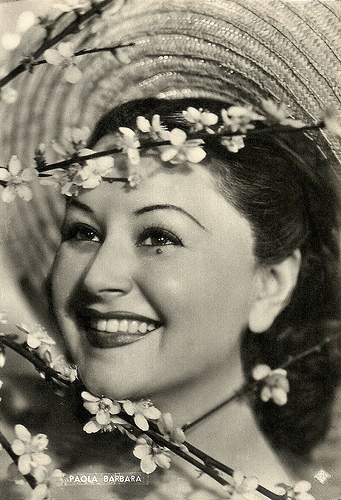
Italian postcard by ASER (A. Scaramaglia Edizioni Roma). Photo: Ghergo.
Jealous Courtesan
Paola Barbara was born Paola Proto in Rome, in 1912. From the late 1930s to the late 1940s she was one the most popular and prolific actresses in Italy. Occasionally she used the pseudonym Paulien Baards (baard is Dutch for beard, barba is Italian for beard). Barbara’s career stated with a small part in Campo di maggio/100 Days of Napoleon (Giovacchino Forzano, 1935) and quickly became successful. In the comedy Ammazzoni bianche/White Amazons (Gennaro Righelli, 1936), Barbara had the lead, opposite Sandro Ruffini and Doris Duranti. In the late 1930s Barbara also founded her own stage company, Gizzi-Barbara-Annicelli. In the mid-1930s she was active at the Pisorno studios at Tirrenia, near Livorno. From the late 1930s on she mainly worked in Rome, e.g. at the Scalera studios. Barbara acted in many comedies by Guido Brignone, Mario Mattoli, Amleto Palermi and Giacomo Gentilomo, but also in dramas by Marco Elter and Raffaele Matarazzo. In the adventure and spy story Lotte nell’ombra/Battles in the Shadow (Domenico Gambino, 1939), she co-starred with Antonio Centa and Silvana Jacchino. In Il ponte dei sospiri/The bridge of sighs (Mario Bonnard, 1940), a remake of a period piece set in Venice, Barbara was the courtesan Imperiale, who out of jealousy falsely accuses her ex-lover Rolando Candiano (Otello Toso) of having murdered her husband. Already in 1921 there had been a silent version of Il ponte dei sospiri/The bridge of sighs (Domenico Gaido, 1924), with Luciano Albertini as Rolando and Antonietta Calderari as his jealous and vengeful ex.
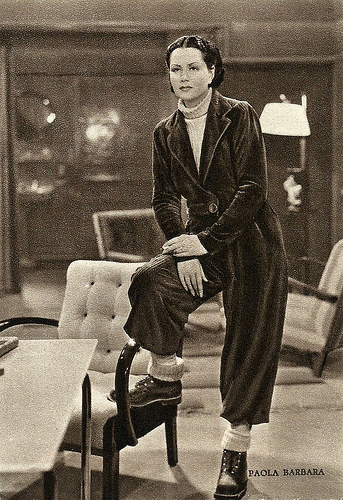
Italian postcard by Rizzoli, Milan, 1936-XV.
A First, Modest Step Towards Italian Neorealism
Paola Barbara’s best and most acclaimed part was the lead in Amleto Palermi’s film La peccatrice/The Sinner (1940). It tells the story of a naive provincial town girl whose hypocrite lover (Gino Cervi) has promised to marry her but dumps her when she is pregnant. Out of shame she runs away from home, loses her child and becomes nanny to a farmer’s family in another provincial town. There a new lover (Vittorio De Sica) treats her meanly, when he knows of her past, so runs away again. Moved to the city she is forced to become a prostitute. The death of another prostitute from the same brothel makes her realize the low depths of her life, so she returns to her mother in the countryside. There she meets the man who started all her misery, menaces him with a knife and expresses all her bitterness. Relieved, she leaves the inn. La peccatrice was already shot in 1938 but only released in Italy in September 1940, after being shown at the Venice film festival. Afterwards it has been interpreted as a first, modest step towards Italian neorealism. The film was shot at the Centro Sperimentale di Cinematografia, the Roman film academy, with sets by Antonio Valente, who taught scenography at the academy (1936-1968) and had also been the architect of the new building (opened 1940).
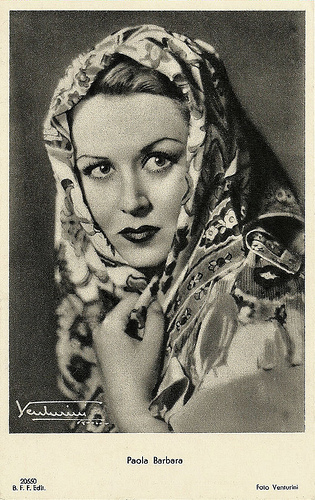
Italian postcard by Ballerini & Fratini, Florence, no. 20680. Photo: Venturini.
In Madrid
Paola Barbara married director Primo Zeglio, who directed her in nine films. In 1943 they fled to Spain because of the war in Italy and stayed there until c. 1947. In Madrid Zeglio first directed Barbara in Febbre/Fever (1943), and Accadde a Damasco/It Happened in Dasmascus (1943). Later Barbara also acted in various films by Spanish directors, such as Luis Marquina, Carlos Arevalos, Juan de Orduna, Rafael Gil, and Florian Rey. During their stay in Madrid, Barbara had the possibility to work on dubbing American films by 20th Century Fox, destined for the Italian market once the war would be over. She collaborated on the dubbing with Italian actors who were in Spain as well to act in Italo-Spanish productions, such as Emilio Cigoli, Anita Farra, Felice Romano, Nerio Bernardi, and Franco Coop. Films she helped dubbing were How Green Was My Valley, Charley’s Aunt, Suspect, The Sign of Zorro and The Shadow of a Doubt. Until 1949 Barbara alternated acting in Italy with films shot in Spain. Zeglio continued to direct her in several Italian productions, such as the epic Nerone e Messalina/Nero and the Burning of Rome (1953), in which she played Nero’s mother Agrippina opposite Gino Cervi as Nero and Yvonne Sanson as Messalina. While her parts were still substantial in the 1950s, slowly they became less prominent in the 1960s. This was even so in the films by her husband, such as the western I quattri inesorabili/The Relentless Four (1965), starring Adam West. She returned to the stage in the 1950s with her company Barbara-Tamberlani-Villa, and was succesful in plays such as ...poi venne l'alba (then came the dawn ...) (1956) and Processo di secondo instanza (1967). The last film parts of Barbara were e.g. in Sidney Lumet’s psychological drama The Appointment (1969) starring Omar Sharif, the western A Man Called Sledge (Vic Morrow, 1971) starring James Garner, and Irene, Irene (Peter Del Monte, 1975), starring Alain Cuny. Paola Barbara died in Anguillara Sabazia, in 1989. She was 77.
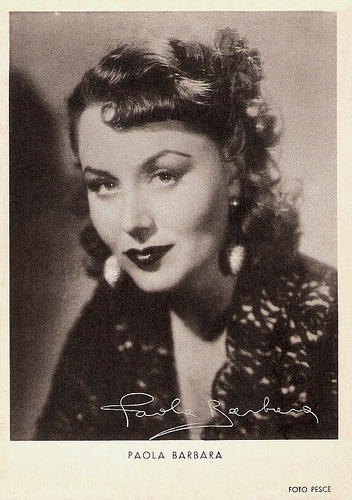
Italian postcard by Casa Editrice Albora, Milano, no. 1950. Photo: Pesce.
Sources:

Italian postcard by ASER (A. Scaramaglia Edizioni Roma). Photo: Ghergo.
Jealous Courtesan
Paola Barbara was born Paola Proto in Rome, in 1912. From the late 1930s to the late 1940s she was one the most popular and prolific actresses in Italy. Occasionally she used the pseudonym Paulien Baards (baard is Dutch for beard, barba is Italian for beard). Barbara’s career stated with a small part in Campo di maggio/100 Days of Napoleon (Giovacchino Forzano, 1935) and quickly became successful. In the comedy Ammazzoni bianche/White Amazons (Gennaro Righelli, 1936), Barbara had the lead, opposite Sandro Ruffini and Doris Duranti. In the late 1930s Barbara also founded her own stage company, Gizzi-Barbara-Annicelli. In the mid-1930s she was active at the Pisorno studios at Tirrenia, near Livorno. From the late 1930s on she mainly worked in Rome, e.g. at the Scalera studios. Barbara acted in many comedies by Guido Brignone, Mario Mattoli, Amleto Palermi and Giacomo Gentilomo, but also in dramas by Marco Elter and Raffaele Matarazzo. In the adventure and spy story Lotte nell’ombra/Battles in the Shadow (Domenico Gambino, 1939), she co-starred with Antonio Centa and Silvana Jacchino. In Il ponte dei sospiri/The bridge of sighs (Mario Bonnard, 1940), a remake of a period piece set in Venice, Barbara was the courtesan Imperiale, who out of jealousy falsely accuses her ex-lover Rolando Candiano (Otello Toso) of having murdered her husband. Already in 1921 there had been a silent version of Il ponte dei sospiri/The bridge of sighs (Domenico Gaido, 1924), with Luciano Albertini as Rolando and Antonietta Calderari as his jealous and vengeful ex.

Italian postcard by Rizzoli, Milan, 1936-XV.
A First, Modest Step Towards Italian Neorealism
Paola Barbara’s best and most acclaimed part was the lead in Amleto Palermi’s film La peccatrice/The Sinner (1940). It tells the story of a naive provincial town girl whose hypocrite lover (Gino Cervi) has promised to marry her but dumps her when she is pregnant. Out of shame she runs away from home, loses her child and becomes nanny to a farmer’s family in another provincial town. There a new lover (Vittorio De Sica) treats her meanly, when he knows of her past, so runs away again. Moved to the city she is forced to become a prostitute. The death of another prostitute from the same brothel makes her realize the low depths of her life, so she returns to her mother in the countryside. There she meets the man who started all her misery, menaces him with a knife and expresses all her bitterness. Relieved, she leaves the inn. La peccatrice was already shot in 1938 but only released in Italy in September 1940, after being shown at the Venice film festival. Afterwards it has been interpreted as a first, modest step towards Italian neorealism. The film was shot at the Centro Sperimentale di Cinematografia, the Roman film academy, with sets by Antonio Valente, who taught scenography at the academy (1936-1968) and had also been the architect of the new building (opened 1940).

Italian postcard by Ballerini & Fratini, Florence, no. 20680. Photo: Venturini.
In Madrid
Paola Barbara married director Primo Zeglio, who directed her in nine films. In 1943 they fled to Spain because of the war in Italy and stayed there until c. 1947. In Madrid Zeglio first directed Barbara in Febbre/Fever (1943), and Accadde a Damasco/It Happened in Dasmascus (1943). Later Barbara also acted in various films by Spanish directors, such as Luis Marquina, Carlos Arevalos, Juan de Orduna, Rafael Gil, and Florian Rey. During their stay in Madrid, Barbara had the possibility to work on dubbing American films by 20th Century Fox, destined for the Italian market once the war would be over. She collaborated on the dubbing with Italian actors who were in Spain as well to act in Italo-Spanish productions, such as Emilio Cigoli, Anita Farra, Felice Romano, Nerio Bernardi, and Franco Coop. Films she helped dubbing were How Green Was My Valley, Charley’s Aunt, Suspect, The Sign of Zorro and The Shadow of a Doubt. Until 1949 Barbara alternated acting in Italy with films shot in Spain. Zeglio continued to direct her in several Italian productions, such as the epic Nerone e Messalina/Nero and the Burning of Rome (1953), in which she played Nero’s mother Agrippina opposite Gino Cervi as Nero and Yvonne Sanson as Messalina. While her parts were still substantial in the 1950s, slowly they became less prominent in the 1960s. This was even so in the films by her husband, such as the western I quattri inesorabili/The Relentless Four (1965), starring Adam West. She returned to the stage in the 1950s with her company Barbara-Tamberlani-Villa, and was succesful in plays such as ...poi venne l'alba (then came the dawn ...) (1956) and Processo di secondo instanza (1967). The last film parts of Barbara were e.g. in Sidney Lumet’s psychological drama The Appointment (1969) starring Omar Sharif, the western A Man Called Sledge (Vic Morrow, 1971) starring James Garner, and Irene, Irene (Peter Del Monte, 1975), starring Alain Cuny. Paola Barbara died in Anguillara Sabazia, in 1989. She was 77.

Italian postcard by Casa Editrice Albora, Milano, no. 1950. Photo: Pesce.
Sources:
Published on July 23, 2013 23:00
July 22, 2013
Rocco Granata
Rocco Granata (1938) is a Belgian-Italian singer and an occasional actor. In 1959, he had an international smash hit with the song Marina. He toured the world and even performed at Carnegie Hall in New York. A feature film entitled Marina was released in 1960, which set the stage for a string of German hits and Schlagerfilms.
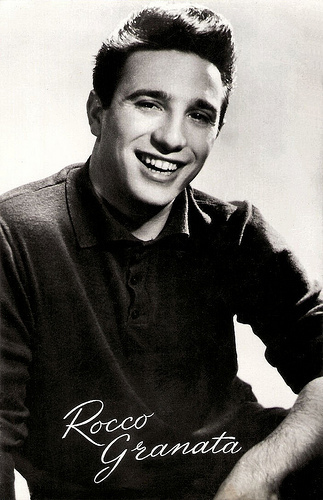
Dutch postcard by Takken, Utrecht, no. AX 4545. Publicity card for the monthly Juke Box.
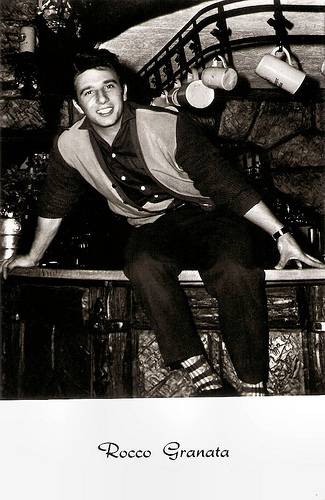
Dutch postcard by Int. Filmpers (I.F.P.), no. WPS 22. Publicity card for the magazine Song Parade.
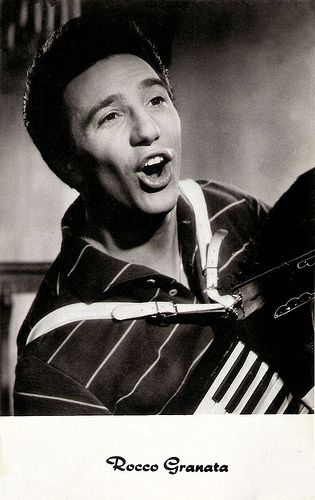
Dutch postcard.
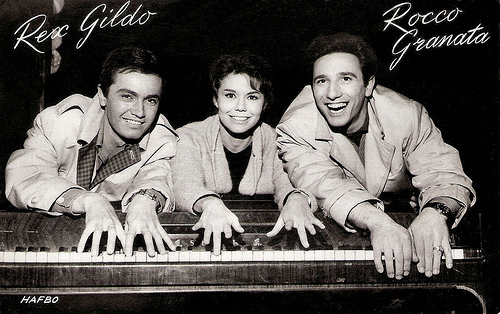
Dutch postcard by Uitg. Takken, Utrecht, no. AX 4687. Photo: Hafbo. Publicity still for the Schlagerfilm Marina (Paul Martin, 1960), which was distributed in Holland as Teenagers Schlager Parade. The girl between Rex Gildo and Rocco Granata is the female lead of the film, Italian actress Giorgia Moll.
Manuela and Marina
Rocco Granata was born in Figline Vegliaturo in the South of Italy in 1938. When he was ten years old his family left sunny Calabria for the cold Belgian mining district. At the age of fifteen his father allowed him to skip school and he started working as a mechanic in a Vespa-shop. During the weekends, Rocco toured Belgium with his band The International Quintet. First he only played accordion, but soon he also became the singer of the band. He started singing sentimental Italian ballads. One of these songs was especially loved by the dancing crowd: Manuela. In 1959 he released Manuela as a single, but instead the B-side, Marina, became an international smash hit. Marina hit #1 in Belgium as well as charts across Europe and in America. Over 40 years, the single would sell a recordedly one hundred million copies worldwide. It has been covered many times by artists such as Dalida, Dean Martin, Celia Cruz and Louis Armstrong. After the success of Marina, Rocco toured around the world, including dates at Carnegie Hall and the San Remo Festival. Granata sang and acted in a dozen German and Belgian films. His debut Marina (Paul Martin, 1960) set the stage for a string of German hit records such as Buona Notte Bambino in 1963. More Schlagerfilms followed, including Gauner-Serenade/Rogue Serenade (Thomas Engel, 1960), Hochzeit am Neusiedler See/Wedding at Lake Neusiedler (Rolf Olsen, 1963), and Ein Ferienbett mit 100 PS/A Holiday Sleeper with 100 HP (Wolfgang Becker, 1965) starring Vivi Bach.
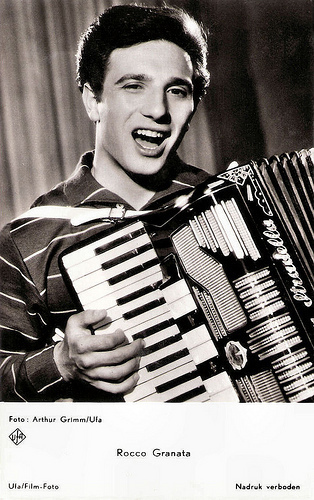
Dutch postcard by gebr. Spanjersberg N.V., Rotterdam, no. 4862. Photo: Arthur Grimm / Ufa.
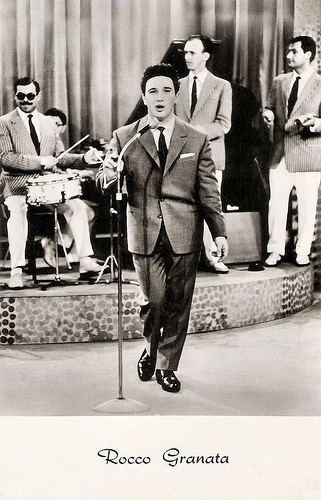
Dutch postcard, no. 1061.
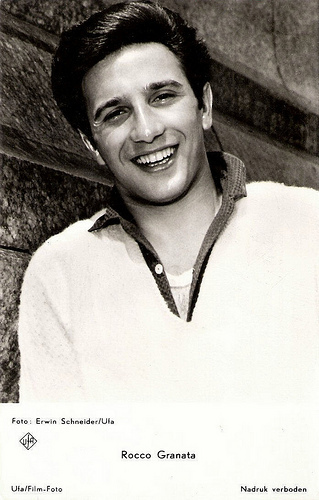
Dutch postcard by Gebr. Spanjersberg, Rotterdam (Dutch licence holder of Ufa/Film-Foto, Berlin), no. 4876, ca. 1961. Photo: Erwin Scheider / Ufa.
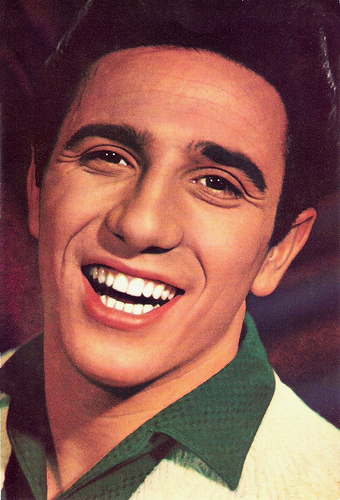
Vintage postcard.
Arthouse
In the mid-sixties Rocco Granata became a successful record producer. He owned the music publishing company Granata Music Editions and his own record company Cardinal Records. He started producing for Belgian artists such as Marva, Louis Neefs and Miel Cools. Occasionally he acted in Belgian films like Jonny en Jessy/Johnny and Jessy (Wies Andersen, 1972) and Zware jongens/Tough Guys (Robbe de Hert, 1984). His song Buona Notte Bambino featured prominently at the soundtrack of the German arthouse film Händler der vier Jahreszeiten/The Merchant of the Four Seasons (1971), directed by the legendary Rainer Werner Fassbinder. In 1989, Granata commissioned a dance remix of Marina, which again topped the Belgian charts as well as those of Italy and Germany. He has appeared regularly on Belgian television, and served as a jury member for the 2002 Flemish preliminaries for The Eurovision Song Contest. In 2008 he was awarded a Lifetime Achievement Award by the Belgian music industry. He made cd's like Paisellu Miu (2007), and Ricominciamo (2010) with autobiographical songs full of longing and nostalgia, love and passion. Over the course of his career, Rocco Granata has released some 65 albums. Although he has sold many copies of his other songs (altogether he made it 9 times to the top 10 of the Belgian hitparades), the enormity of the success of Marina basically has reduced Rocco to a one-hit wonder. In 2011, Rocco Granata presented a new album, Rocco con Buscemi, with DJ Dirk Swartenbroekx, aka Buscemi. The single O Sarracino was a small hit and can be heard on the soundtrack of the Dutch comedy Valentino (Remy van Heugten, 2013). A motion picture about his life, Marina, will be released later this year. In the film directed by Stijn Coninx, Rocco Granata is played by Matteo Simoni (Rocco as teenager) and by Cristiaan Campagna (the young Rocco).
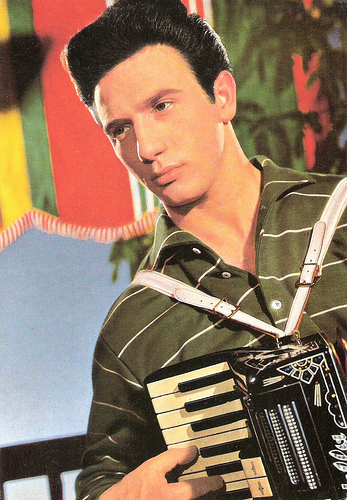
German postcard by Terra-Color, no. F 188.
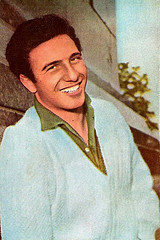
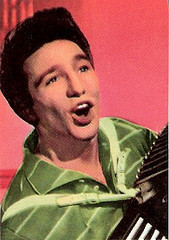
Belgian collector's card, no. 10, and cut-out piece of a Dutch postcard.
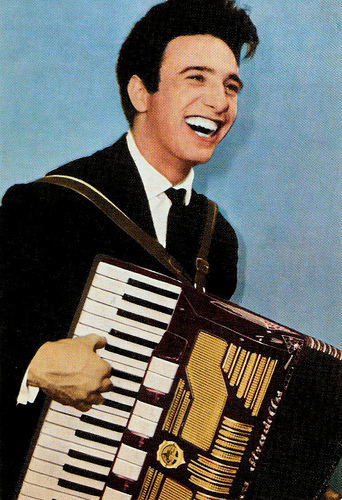
Dutch postcard.
Clip of Rocco Granata performing Marina (1959 version). Source: Imj 22 (YouTube).
Clip of O Sarracino. Source: Mostiko2 (YouTube).
Sources: RoccoGranata.be, The Belgian Pop & Rock Archives, Wikipedia and

Dutch postcard by Takken, Utrecht, no. AX 4545. Publicity card for the monthly Juke Box.

Dutch postcard by Int. Filmpers (I.F.P.), no. WPS 22. Publicity card for the magazine Song Parade.

Dutch postcard.

Dutch postcard by Uitg. Takken, Utrecht, no. AX 4687. Photo: Hafbo. Publicity still for the Schlagerfilm Marina (Paul Martin, 1960), which was distributed in Holland as Teenagers Schlager Parade. The girl between Rex Gildo and Rocco Granata is the female lead of the film, Italian actress Giorgia Moll.
Manuela and Marina
Rocco Granata was born in Figline Vegliaturo in the South of Italy in 1938. When he was ten years old his family left sunny Calabria for the cold Belgian mining district. At the age of fifteen his father allowed him to skip school and he started working as a mechanic in a Vespa-shop. During the weekends, Rocco toured Belgium with his band The International Quintet. First he only played accordion, but soon he also became the singer of the band. He started singing sentimental Italian ballads. One of these songs was especially loved by the dancing crowd: Manuela. In 1959 he released Manuela as a single, but instead the B-side, Marina, became an international smash hit. Marina hit #1 in Belgium as well as charts across Europe and in America. Over 40 years, the single would sell a recordedly one hundred million copies worldwide. It has been covered many times by artists such as Dalida, Dean Martin, Celia Cruz and Louis Armstrong. After the success of Marina, Rocco toured around the world, including dates at Carnegie Hall and the San Remo Festival. Granata sang and acted in a dozen German and Belgian films. His debut Marina (Paul Martin, 1960) set the stage for a string of German hit records such as Buona Notte Bambino in 1963. More Schlagerfilms followed, including Gauner-Serenade/Rogue Serenade (Thomas Engel, 1960), Hochzeit am Neusiedler See/Wedding at Lake Neusiedler (Rolf Olsen, 1963), and Ein Ferienbett mit 100 PS/A Holiday Sleeper with 100 HP (Wolfgang Becker, 1965) starring Vivi Bach.

Dutch postcard by gebr. Spanjersberg N.V., Rotterdam, no. 4862. Photo: Arthur Grimm / Ufa.

Dutch postcard, no. 1061.

Dutch postcard by Gebr. Spanjersberg, Rotterdam (Dutch licence holder of Ufa/Film-Foto, Berlin), no. 4876, ca. 1961. Photo: Erwin Scheider / Ufa.

Vintage postcard.
Arthouse
In the mid-sixties Rocco Granata became a successful record producer. He owned the music publishing company Granata Music Editions and his own record company Cardinal Records. He started producing for Belgian artists such as Marva, Louis Neefs and Miel Cools. Occasionally he acted in Belgian films like Jonny en Jessy/Johnny and Jessy (Wies Andersen, 1972) and Zware jongens/Tough Guys (Robbe de Hert, 1984). His song Buona Notte Bambino featured prominently at the soundtrack of the German arthouse film Händler der vier Jahreszeiten/The Merchant of the Four Seasons (1971), directed by the legendary Rainer Werner Fassbinder. In 1989, Granata commissioned a dance remix of Marina, which again topped the Belgian charts as well as those of Italy and Germany. He has appeared regularly on Belgian television, and served as a jury member for the 2002 Flemish preliminaries for The Eurovision Song Contest. In 2008 he was awarded a Lifetime Achievement Award by the Belgian music industry. He made cd's like Paisellu Miu (2007), and Ricominciamo (2010) with autobiographical songs full of longing and nostalgia, love and passion. Over the course of his career, Rocco Granata has released some 65 albums. Although he has sold many copies of his other songs (altogether he made it 9 times to the top 10 of the Belgian hitparades), the enormity of the success of Marina basically has reduced Rocco to a one-hit wonder. In 2011, Rocco Granata presented a new album, Rocco con Buscemi, with DJ Dirk Swartenbroekx, aka Buscemi. The single O Sarracino was a small hit and can be heard on the soundtrack of the Dutch comedy Valentino (Remy van Heugten, 2013). A motion picture about his life, Marina, will be released later this year. In the film directed by Stijn Coninx, Rocco Granata is played by Matteo Simoni (Rocco as teenager) and by Cristiaan Campagna (the young Rocco).

German postcard by Terra-Color, no. F 188.


Belgian collector's card, no. 10, and cut-out piece of a Dutch postcard.

Dutch postcard.
Clip of Rocco Granata performing Marina (1959 version). Source: Imj 22 (YouTube).
Clip of O Sarracino. Source: Mostiko2 (YouTube).
Sources: RoccoGranata.be, The Belgian Pop & Rock Archives, Wikipedia and
Published on July 22, 2013 23:00
July 21, 2013
Painted by Tito Corbella
Tito Corbella (1885-1966) sure knew how to paint a woman sensuously! The Italian illustrator, commercial artist and painter portrayed several divas of the Italian cinema of the 1910s, and their portraits were used for very popular postcards.
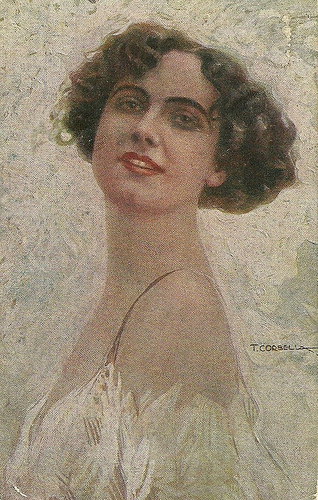
Francesca Bertini by Tito Corbella. Italian postcard by Ufficio Rev. Stampa, no.894, Milano, 25-5-1917.
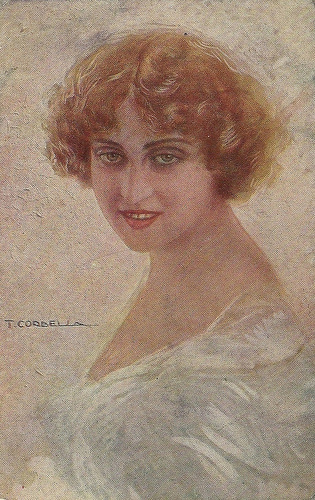
Pina Menichelli painted by Tito Corbella. Italian postcard by Uff. Rev. Stampa, no. 894, 25-5-1917.
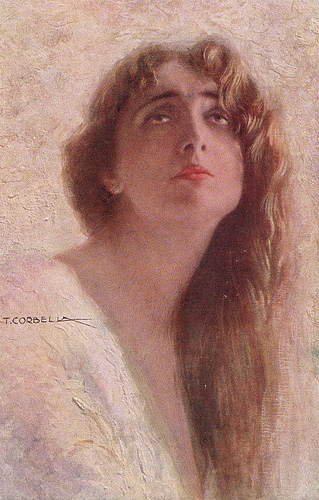
Lyda Borelli by Tito Corbella. Italian postcard by Uff. Rev. Stampa, no. 894, 25-5-1917.
Tito Corbella was born in Pontremoli, Italy in 1885 or 1886 (sources differ). He first studied Chemistry in Padua, then studied at the Academy of Fine Arts in Venice where he was a pupil of Guglielmo Ciardi and Ettore Tito. He remained working in Venice, using his wife as his inspiration for many of his works. Most of his subject matter was a sensual depiction of women and engaged couples. Corbella worked often in publicity, such as for Ricordi of Milan, but he also did non-commercial painting. Corbella painted the theatre and film stars of the 1910s, such as Lyda Borelli and Francesca Bertini. His depictions of them were massively distributed as postcards. During his life, Corbella created over 300 postcard designs, all of which were produced in Italy. He also designed several sets of propaganda postcards during WWI, but collectors prefer his glamorous ladies. Tito Corbella died in 1966 in Rome.
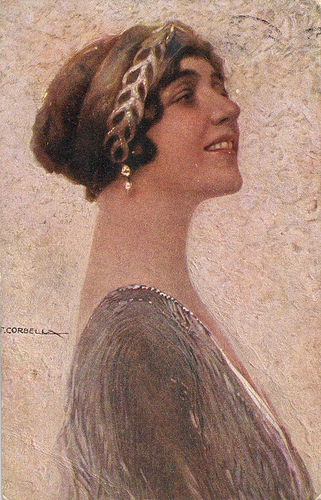
Lina Cavalieri by Tito Corbella. Italian postcard by Uff. Rev. Stampa, no. 894, Milano, 25-5-1917. Corbella painted the portrait after a photo in a kind of Paul Poiret fashion.
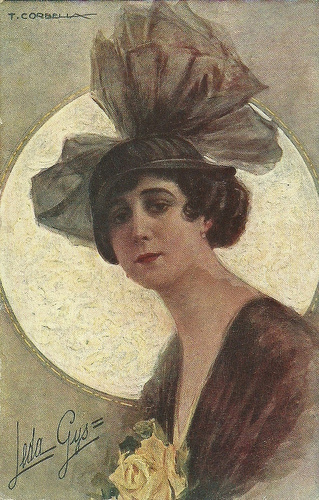
Leda Gys by Tito Corbella. Italian postcard.
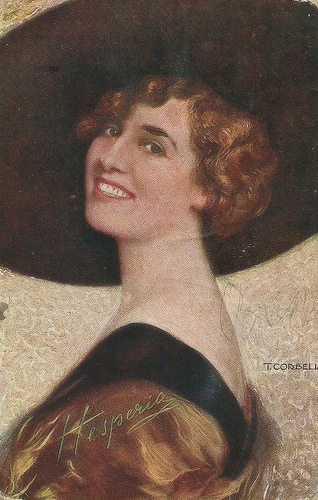
Hesperia by Tito Corbella. Italian postcard by Uff. Rev. Stampa, no. 229, Milano, 2-4-1917.
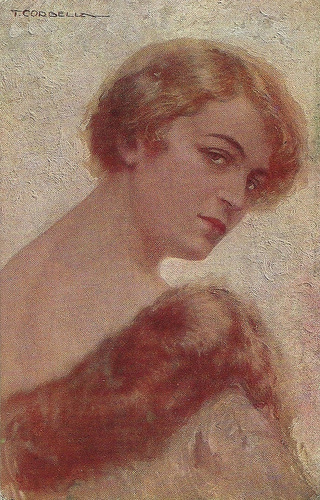
Diana Karenne by Tito Corbella. Italian postcard by Uff. Rev. Stampa, no. 894, Milano, 25-5-1917.
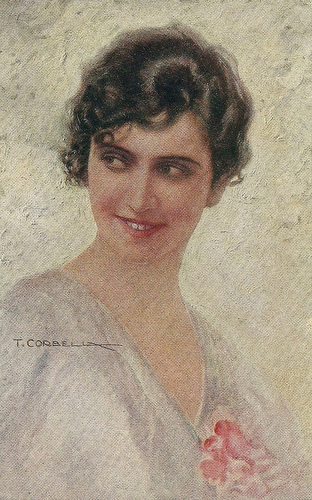
Maria Jacobini by Tito Corbella. Italian postcard by Uff. Rev. Stampa, Milano, no. 891.

Francesca Bertini by Tito Corbella. Italian postcard by Ufficio Rev. Stampa, no.894, Milano, 25-5-1917.

Pina Menichelli painted by Tito Corbella. Italian postcard by Uff. Rev. Stampa, no. 894, 25-5-1917.

Lyda Borelli by Tito Corbella. Italian postcard by Uff. Rev. Stampa, no. 894, 25-5-1917.
Tito Corbella was born in Pontremoli, Italy in 1885 or 1886 (sources differ). He first studied Chemistry in Padua, then studied at the Academy of Fine Arts in Venice where he was a pupil of Guglielmo Ciardi and Ettore Tito. He remained working in Venice, using his wife as his inspiration for many of his works. Most of his subject matter was a sensual depiction of women and engaged couples. Corbella worked often in publicity, such as for Ricordi of Milan, but he also did non-commercial painting. Corbella painted the theatre and film stars of the 1910s, such as Lyda Borelli and Francesca Bertini. His depictions of them were massively distributed as postcards. During his life, Corbella created over 300 postcard designs, all of which were produced in Italy. He also designed several sets of propaganda postcards during WWI, but collectors prefer his glamorous ladies. Tito Corbella died in 1966 in Rome.

Lina Cavalieri by Tito Corbella. Italian postcard by Uff. Rev. Stampa, no. 894, Milano, 25-5-1917. Corbella painted the portrait after a photo in a kind of Paul Poiret fashion.

Leda Gys by Tito Corbella. Italian postcard.

Hesperia by Tito Corbella. Italian postcard by Uff. Rev. Stampa, no. 229, Milano, 2-4-1917.

Diana Karenne by Tito Corbella. Italian postcard by Uff. Rev. Stampa, no. 894, Milano, 25-5-1917.

Maria Jacobini by Tito Corbella. Italian postcard by Uff. Rev. Stampa, Milano, no. 891.
Published on July 21, 2013 23:00
July 20, 2013
Jean Murat
French actor Jean Murat (1888-1968) became a star as a handsome young soldier in silent films of the 1920s. Later, he appeared in such classic French films as La Kermesse Heroique (1935) and L'Eternel Retour (1943).
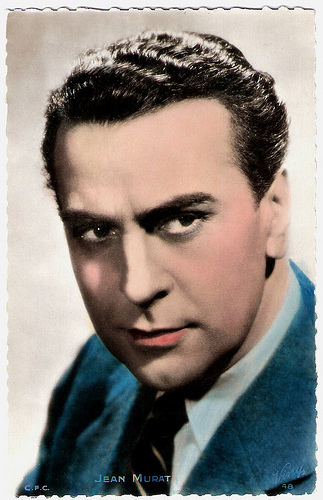
French postcard by Viny, no. 48. Photo: C.F.C.
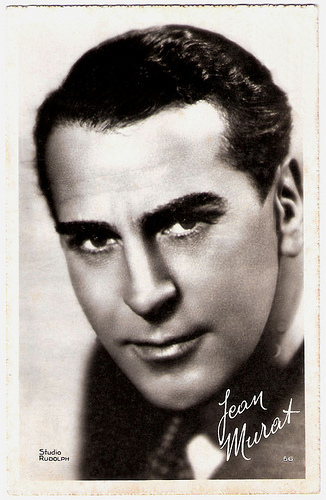
French postcard, no. 56. Photo: Studio Rudolph.
Handsome and Honourable Young Man
Jean Murat was born in Périgueux in the Dordogne in 1888. He studied in Périgueux and Rennes, and also in Indochina. Murat started his career as a correspondent in Berlin for a French newspaper. After serving in the First World War as a news correspondent, he began an acting career. He made his first, uncredited film appearance in Mothers of Men (Edward José, 1921). His first major role was in Souvent Femme Varie/Forsaking All Others (Jean Legrand, 1923) opposite Claude France. He played supporting parts in the epic silent version of Georges Bizet’s opera Carmen (Jacques Feyder, 1926) starring Raquel Meller, the drama La proie du vent/The Prey of the Wind (René Clair, 1927) with Charles Vanel, and the last (silent) film of Hollywood star Constance Talmadge, the society comedy Vénus (Louis Mercanton, 1929). Apart from the handsome and honourable young man roles he also played unsympathetic roles in films like La galerie des monstres/The Gallery of Monsters (Jaque Catelain, 1924) with Lois Moran. He also appeared in several German productions such as Valencia (Jaap Speyer, 1927) with María Dalbaicín and Oscar Marion, Heimweh/Homesick (Gennaro Righelli, 1927) starring Mady Christians, and Flucht aus der Hölle/Escape from Hell (Georg Asagaroff, 1928) with Fritz Alberti. A success was his role in the early talkie La Nuit est à Nous/The Night is Ours (Roger Lion, Henry Roussel, 1928) with Marie Bell. This Ufa production was an alternate language version of Die Nacht gehört uns/The Night is Ours (Carl Froelich, Henry Roussel, 1929) with Charlotte Ander and Hans Albers. The sound film allowed audiences to hear his beautiful deep voice. Another success was the Paramount production Un Trou dans le Muir/The Hole In the Wall (René Barberis, 1930) with Dolly Davis, based on a play by Yves Mirande. He also appeared opposite the Italian diva Francesca Bertini in La femme d'une nuit/Woman of One Night (Marcel L'Herbier, 1930).
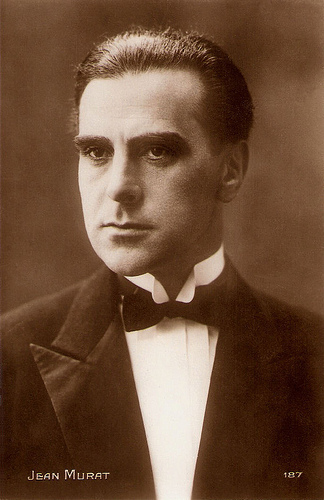
French postcard by Cinémagazine-Edition, Paris, no. 187.
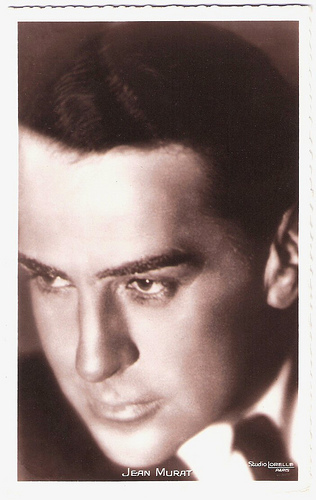
French postcard. Photo: Studio Lorelle, Paris.
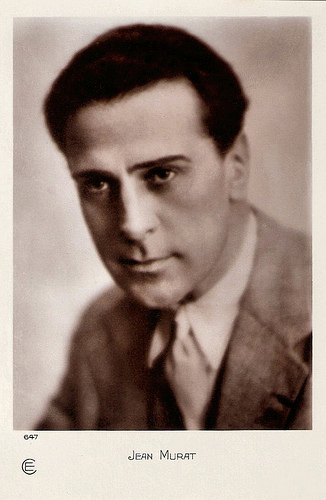
French postcard by Cinémagazine-Sélection, Paris, no. 647.
Eternal Return
Even in his forties, Jean Murat retained the youthful leading man looks that had vaulted him to stardom. In 1931 he married the gorgeous actress Annabella. Together they starred in films like Paris-Méditerranée/Companion Wanted (Joe May, 1932), Mademoiselle Josette, ma femme/Miss Josette, My Wife (André Berthomieu, 1933) and L'équipage/Flight into Darkness (Anatole Litvak, 1935). The pair divorced in 1938. Among Murat’s most famous roles were the Duke in La Kermesse Heroique/Carnival in Flanders (Jacques Feyder, 1935) and Marc in L'Eternel Retour/Eternal Return (Jean Delannoy, 1943) starring Jean Marais. La Kermesse Heroique is set during the war between the Dutch and Spanish. A tiny village in Flanders is invaded by Spanish troops. The townsfolk have heard of Spanish cruelties in other towns, and decide to deflect the vanquishers with a lavish carnival. The award winning film was banned in Germany. Josef Goebbels caught on that director Jacques Feyder and scenarists Bernard Zimmer and Charles Spaak were drawing deliberate parallels between the Spanish and the then-burgeoning Nazis. At Films de France, James Travers writes: “This enduring classic of French cinema is often cited as director Jacques Feyder’s finest film and it certainly earned him great acclaim on its release in 1935.” L'Eternel Retour is a translation of the Tristan and Isolde legend into contemporary terms. According to Hal Erickson at AllMovie , “the dream-like quality of Eternal Return is due more to the input of screenwriter Jean Cocteau than director Delannoy. The film, with its mystical trappings and ethereal performances, can now be viewed as a precursor to Cocteau's own Beauty and the Beast.” James Travers at Films de France notes: “The result is an intensely moving film about love, jealousy and malice, captivating in its lyrical charm, yet haunting in its assessment of the worst in human nature.”
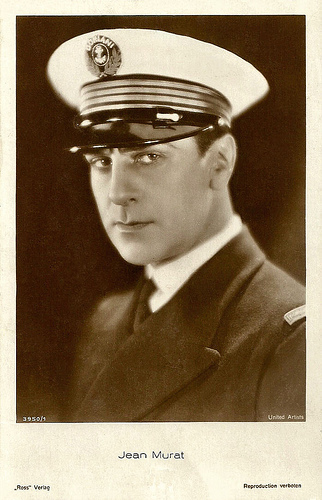
German postcard by Ross Verlag, no. 3950/1, 1928-1929. Photo: United Artists.
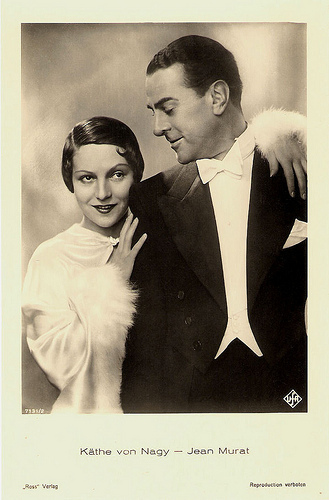
German postcard by Ross Verlag, no. 7131/2, 1932-1933. Photo: Ufa.
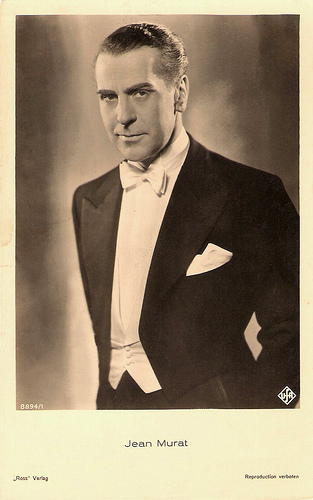
German postcard by Ross Verlag, no. 8894/1, 1933-1934 Photo: Ufa.
Lady Chatterley’s Lover
From the 1940s on, Jean Murat became a bit old for the roles of handsome leading man, and he interpreted mainly supporting roles in such films as Bethsabée (Léonide Moguy, 1947) with Danielle Darrieux and Georges Marchal. Murat's handful of English-languages appearances include On the Riviera (Walter Lang, 1951) with Danny Kaye and the MGM musical Rich, Young and Pretty (Norman Taurog, 1951) starring Jane Powell. Hal Erickson writes that “neither of which were worthy of his talents”. Among his better known French films were Si Versailles m’était conté/Royal Affairs in Versailles (Sacha Guitry, 1954), the Jean-Paul Sartre adaptation Huis Clos/No Exit (Jacqueline Audry, 1954) with Arletty, and L'Amant de Lady Chatterley/Lady Chatterley’s Lover (Marc Allégret, 1955) starring Danielle Darrieux and based on the famously forbidden novel by D.H. Lawrence. Successful were also Les Grandes Familles/The Great Families (Denys de la Patelliere, 1958), and Les Miserables (Jean-Paul Le Chanois, 1958), both starring Jean Gabin. James Travers describes Les Grandes Familles as “a pretty run-of the-mill drama concerned with a deadly feud between two cousins of a notoriously successful family dynasty.” Among his last films were the episode L’ Envie/Envy by Edouard Molinaro in the portmanteau Les Sept Péchés Capitaux/The Seven Mortal Sins (1962), and the Jayne Mansfield vehicle It Happened in Athens (Andrew Marton, 1962). Jean Murat died in 1968 by coronary thrombosis in Aix-en-Provence, France. He was 79. He and Annabella had a daughter.
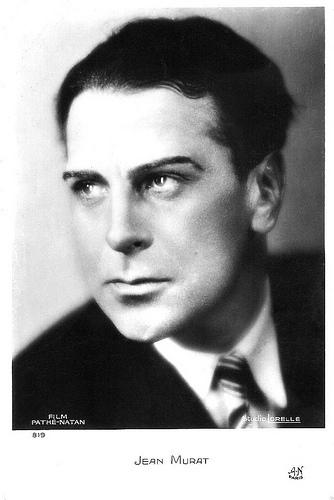
French postcard by A.N., Paris, no. 819. Photo: Studio Lorelle / Film Pathé-Natan.
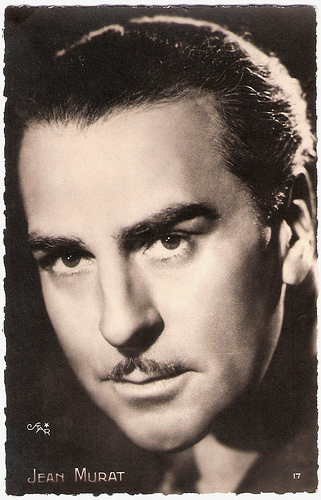
French postcard by Editions O.P., Paris, no. 17. Photo: Star.
Scenes from L'Eternel Retour/Eternal Return (1943). Source: adhepe (YouTube).
Sources: Hal Erickson (AllMovie), James Travers (Films de France), Wikipedia (French), and

French postcard by Viny, no. 48. Photo: C.F.C.

French postcard, no. 56. Photo: Studio Rudolph.
Handsome and Honourable Young Man
Jean Murat was born in Périgueux in the Dordogne in 1888. He studied in Périgueux and Rennes, and also in Indochina. Murat started his career as a correspondent in Berlin for a French newspaper. After serving in the First World War as a news correspondent, he began an acting career. He made his first, uncredited film appearance in Mothers of Men (Edward José, 1921). His first major role was in Souvent Femme Varie/Forsaking All Others (Jean Legrand, 1923) opposite Claude France. He played supporting parts in the epic silent version of Georges Bizet’s opera Carmen (Jacques Feyder, 1926) starring Raquel Meller, the drama La proie du vent/The Prey of the Wind (René Clair, 1927) with Charles Vanel, and the last (silent) film of Hollywood star Constance Talmadge, the society comedy Vénus (Louis Mercanton, 1929). Apart from the handsome and honourable young man roles he also played unsympathetic roles in films like La galerie des monstres/The Gallery of Monsters (Jaque Catelain, 1924) with Lois Moran. He also appeared in several German productions such as Valencia (Jaap Speyer, 1927) with María Dalbaicín and Oscar Marion, Heimweh/Homesick (Gennaro Righelli, 1927) starring Mady Christians, and Flucht aus der Hölle/Escape from Hell (Georg Asagaroff, 1928) with Fritz Alberti. A success was his role in the early talkie La Nuit est à Nous/The Night is Ours (Roger Lion, Henry Roussel, 1928) with Marie Bell. This Ufa production was an alternate language version of Die Nacht gehört uns/The Night is Ours (Carl Froelich, Henry Roussel, 1929) with Charlotte Ander and Hans Albers. The sound film allowed audiences to hear his beautiful deep voice. Another success was the Paramount production Un Trou dans le Muir/The Hole In the Wall (René Barberis, 1930) with Dolly Davis, based on a play by Yves Mirande. He also appeared opposite the Italian diva Francesca Bertini in La femme d'une nuit/Woman of One Night (Marcel L'Herbier, 1930).

French postcard by Cinémagazine-Edition, Paris, no. 187.

French postcard. Photo: Studio Lorelle, Paris.

French postcard by Cinémagazine-Sélection, Paris, no. 647.
Eternal Return
Even in his forties, Jean Murat retained the youthful leading man looks that had vaulted him to stardom. In 1931 he married the gorgeous actress Annabella. Together they starred in films like Paris-Méditerranée/Companion Wanted (Joe May, 1932), Mademoiselle Josette, ma femme/Miss Josette, My Wife (André Berthomieu, 1933) and L'équipage/Flight into Darkness (Anatole Litvak, 1935). The pair divorced in 1938. Among Murat’s most famous roles were the Duke in La Kermesse Heroique/Carnival in Flanders (Jacques Feyder, 1935) and Marc in L'Eternel Retour/Eternal Return (Jean Delannoy, 1943) starring Jean Marais. La Kermesse Heroique is set during the war between the Dutch and Spanish. A tiny village in Flanders is invaded by Spanish troops. The townsfolk have heard of Spanish cruelties in other towns, and decide to deflect the vanquishers with a lavish carnival. The award winning film was banned in Germany. Josef Goebbels caught on that director Jacques Feyder and scenarists Bernard Zimmer and Charles Spaak were drawing deliberate parallels between the Spanish and the then-burgeoning Nazis. At Films de France, James Travers writes: “This enduring classic of French cinema is often cited as director Jacques Feyder’s finest film and it certainly earned him great acclaim on its release in 1935.” L'Eternel Retour is a translation of the Tristan and Isolde legend into contemporary terms. According to Hal Erickson at AllMovie , “the dream-like quality of Eternal Return is due more to the input of screenwriter Jean Cocteau than director Delannoy. The film, with its mystical trappings and ethereal performances, can now be viewed as a precursor to Cocteau's own Beauty and the Beast.” James Travers at Films de France notes: “The result is an intensely moving film about love, jealousy and malice, captivating in its lyrical charm, yet haunting in its assessment of the worst in human nature.”

German postcard by Ross Verlag, no. 3950/1, 1928-1929. Photo: United Artists.

German postcard by Ross Verlag, no. 7131/2, 1932-1933. Photo: Ufa.

German postcard by Ross Verlag, no. 8894/1, 1933-1934 Photo: Ufa.
Lady Chatterley’s Lover
From the 1940s on, Jean Murat became a bit old for the roles of handsome leading man, and he interpreted mainly supporting roles in such films as Bethsabée (Léonide Moguy, 1947) with Danielle Darrieux and Georges Marchal. Murat's handful of English-languages appearances include On the Riviera (Walter Lang, 1951) with Danny Kaye and the MGM musical Rich, Young and Pretty (Norman Taurog, 1951) starring Jane Powell. Hal Erickson writes that “neither of which were worthy of his talents”. Among his better known French films were Si Versailles m’était conté/Royal Affairs in Versailles (Sacha Guitry, 1954), the Jean-Paul Sartre adaptation Huis Clos/No Exit (Jacqueline Audry, 1954) with Arletty, and L'Amant de Lady Chatterley/Lady Chatterley’s Lover (Marc Allégret, 1955) starring Danielle Darrieux and based on the famously forbidden novel by D.H. Lawrence. Successful were also Les Grandes Familles/The Great Families (Denys de la Patelliere, 1958), and Les Miserables (Jean-Paul Le Chanois, 1958), both starring Jean Gabin. James Travers describes Les Grandes Familles as “a pretty run-of the-mill drama concerned with a deadly feud between two cousins of a notoriously successful family dynasty.” Among his last films were the episode L’ Envie/Envy by Edouard Molinaro in the portmanteau Les Sept Péchés Capitaux/The Seven Mortal Sins (1962), and the Jayne Mansfield vehicle It Happened in Athens (Andrew Marton, 1962). Jean Murat died in 1968 by coronary thrombosis in Aix-en-Provence, France. He was 79. He and Annabella had a daughter.

French postcard by A.N., Paris, no. 819. Photo: Studio Lorelle / Film Pathé-Natan.

French postcard by Editions O.P., Paris, no. 17. Photo: Star.
Scenes from L'Eternel Retour/Eternal Return (1943). Source: adhepe (YouTube).
Sources: Hal Erickson (AllMovie), James Travers (Films de France), Wikipedia (French), and
Published on July 20, 2013 23:00
July 19, 2013
Maximilian Schell
Austrian-born Swiss actor Maximilian Schell (1930) won an Oscar for his role as a defense attorney in Judgment at Nuremberg (1961). Many international films and awards would follow. Schell is also a respected writer, director and producer of several films, including intimate portraits of Marlene Dietrich and of his sister Maria Schell.
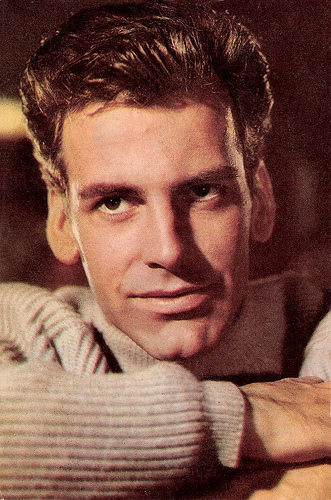
Belgian postcard by Cox, no. 7.
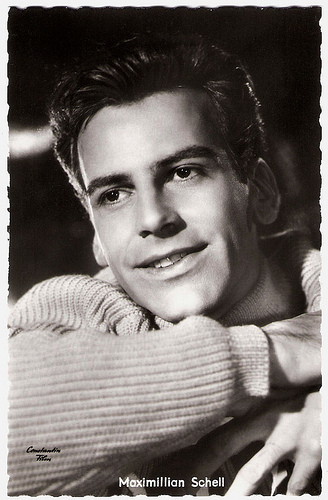
German postcard by Kolibri-Verlag G.m.b.H, Minden-Westf., no. 2445. Photo: Arthur Grimm / CCC / Constantin. Publicity still for Die Letzten werden die Ersten sein/The Last Ones Shall Be First (Rolf Hansen, 1957).
An Accidental Hollywood Career
Maximilian Schell was born in Vienna, Austria in 1930. He was the son of Margarethe Schell née Noe von Nordberg, an actress who ran an acting school, and Hermann Ferdinand Schell, a Swiss poet, novelist, playwright, and owner of a pharmacy. Schell's late elder sister, Maria Schell, was also an actress; as are their two other siblings, Carl and Immy (Immaculata) Schell. When Austria became part of Nazi-Germany after the ‘anschluss’ of 1938, the Schell family moved to Zurich, Switzerland. Maximilian's interest in acting began at early age. When 11, he appeared in a professional production of William Tell and in the same year he wrote a play which was produced by his school. Later he served in the Swiss Army, achieving the rank of corporal. In 1952, he began acting at the Basel Theatre. He played a small role as a desperate deserter in the war film Kinder, Mütter und ein General/Children, Mother, and the General (László Benedek, 1955) starring Hilde Krahl. That year he also played parts in Der 20. Juli/The Plot to Assassinate Hitler (Falk Harnack, 1955), Reifende Jugend/Ripening Youth (Ulrich Erfurth, 1955) and Ein Mädchen aus Flandern/The Girl from Flanders (Helmut Käutner, 1956) with Nicole Berger. His breakthrough in the cinema was the German crime film Die Letzten werden die Ersten sein/The Last Ones Shall Be First (Rolf Hansen, 1957). The film, which starred O.E. Hasse and Ulla Jacobsson, was entered into the 7th Berlin International Film Festival. Schell made his Hollywood debut as a Nazi officer in the World War II film The Young Lions (Edward Dmytryk, 1958) starring Marlon Brando and Montgomery Clift. According to Jon C. Hopwood at IMDb “quite by accident, as the producers had wanted to hire his sister Maria Schell, but lines of communication got crossed, and he was the one hired.” He stayed in America and in 1959, he appeared as Hans Rolfe, an enigmatic defense attorney, in a live Playhouse 90 television production of Judgment at Nuremberg (George Roy Hill, 1959). In 1961, Schell reprised the role for the big screen remake Judgement at Nuremberg (Stanley Kramer, 1961) with an all star cast including Spencer Tracy, Burt Lancaster, and Marlene Dietrich. As the first German speaking actor after World War II, Schell won the Academy Award for Best Actor. He also won a Golden Globe and the New York Film Critics Circle Award for the role. In the following years, Schell starred in international productions like the Italian-French drama I sequestrati di Altona/The Condemned of Altona (Vittorio De Sica, 1962) opposite Sophia Loren, the heist film Topkapi (Jules Dassin, 1964) with Melina Mercouri, the British drama Return from the Ashes (J. Lee Thompson, 1965) with Ingrid Thulin, and the British espionage–thriller The Deadly Affair (Sidney Lumet, 1966) based on John le Carré's first novel Call for the Dead. In Hollywood, he was often top billed in Third Reich themed films, such as Counterpoint (Ralph Nelson, 1968), The Man in the Glass Booth (Arthur Hiller, 1975) – a role for which he was nominated for an Academy Award, Cross of Iron (Sam Peckinpah, 1977), Julia (Fred Zinnemann, 1977) – for which he got another Oscar nomination, and A Bridge Too Far (Richard Attenborough, 1977). However, he also played in various films with different subjects, including the historical disaster film Krakatoa, East of Java (Bernard L. Kowalski, 1969), the science fiction film The Black Hole (Gary Nelson, 1979), and the crime comedy The Freshman (Andrew Bergman, 1990) starring Marlon Brando and Matthew Broderick.
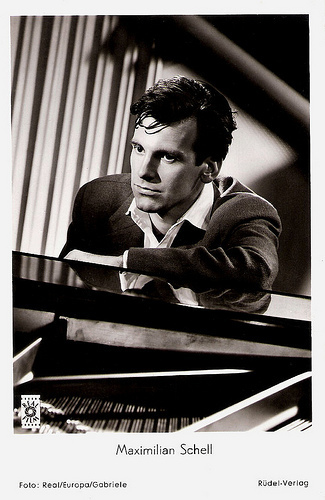
German postcard by Rüdel-Verlag, Hamburg-Bergedorf., no. 1868. Photo: Gabriele / Real / Europa. Publicity still for Ein Herz kehrt heim/A Heart Goes Home (Eugen York, 1956).
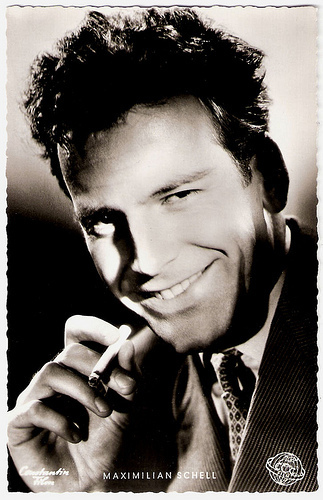
German postcard by Kunst und Bild, Berlin-Charlottenburg, no. V 128. Photo: CCC / Constantin / Arthur Grimm. Publicity still for Die Letzten werden die Ersten sein/The Last Ones Shall Be First (Rolf Hansen, 1957).
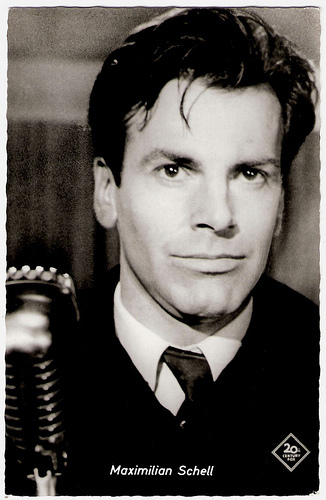
German postcard by Friedr. W. Sander-Verlag, Minden/Kolbri-Karte, no. 2005. Photo: 20th Century Fox. Publicity still for Judgment at Nuremberg (Stanley Kramer, 1961).
Marlene and Maria
Maximilian Schell has also served as a writer, producer and director for a variety of films. In 1968, Schell produced and starred in the adaptation of Kafka's novel Das Schloss/The Castle. Two years later, Erste Liebe/First Love (1970) - written, directed, produced, and starred in by Schell - was hailed by the critics. His Der Fußgänger/The Pedestrian (1974), in which he also starred, was nominated for the Oscar for Best Foreign Language Film and won a Golden Globe. His documentary on Marlene Dietrich, Marlene (1984) was based on the audio tape recordings of his 17-hours-long interview session with Dietrich. Using original footage, documentary material and interview passages, he managed to present an intimate portrait of her, which won also several awards. 18 years later, he made a documentary about his late sister Maria Schell, Meine Schwester Maria/My Sister Maria (2002). Connor McMadden at AllMovie : "Using excerpts of her feature films along with home movie footage, Schell explores the high points his sister's career throughout the 1950s, as well as the personal problems that cast her into obscurity only a decade later. The film offers quite a few emotional peaks, especially when an elderly Maria Schell goes before her brother's camera to speak candidly about her life, and a suicide attempt which she refers to as her 'first death.'" In addition to his film career, Maximilian Schell has also been active as director, writer and actor in the European theatre. In 1958, he made his Broadway debut in Ira Levin’s Interlock. In 1965, he starred in John Osborne’s groundbreaking A Patriot for Me, first at London’s Royal Court Theatre and later on Broadway. He has twice played Hamlet on stage, originally under the direction of the legendary Gustaf Grundgens and later under his own direction. In 1972 he starred in Peter Hall's German language première of Harold Pinter's Old Times at the Burgtheater in Vienna. In 1977 he directed Tales from the Vienna Woods at the National Theatre in London. In later life he also began directing operatic productions, starting with Giuseppe Verdi's La Traviata. This passion was triggered when he was performing in the play Jedermann (Everyman) in Salzburg, Austria from 1978-1982, and he came into contact with several musical conductors including Leonard Bernstein, James Levine and Claudio Abbado. In 2006 he appeared in Arthur Miller's Resurrection Blues directed by Robert Altman at the Old Vic in London. He also often appeared on television, such as in the miniseries Peter the Great (Marvin J. Chomsky, Lawrence Schiller, 1986), with Vanessa Redgrave and Laurence Olivier. He was twice been nominated for an Emmy for his TV work, and in 1993, he won a Golden Globe for his part as Vladimir Lenin in the HBO miniseries Stalin (Ivan Passer, 1992). In 1990, he had refused to receive the Honorary German Film Award because he felt too young to be awarded with an award for lifetime achievement. For German television, he played in the television miniseries The Return of the Dancing Master (Urs Egger, 2004), which was based on Henning Mankell's crime novel. Through the decades he continued to star in international film productions, such as The Rose Garden (Fons Rademakers, 1986), Left Luggage (Jeroen Krabbé, 1998), Deep Impact (Mimi Leder, 1998), Vampires (John Carpenter, 1998), and the American comedy The Brothers Bloom (Rian Johnson, 2008) with Adrien Brody and Mark Ruffalo. At IMDb, Jon C. Hopwood writes: “with the exception of Maurice Chevalier and Marcello Mastroianni, Schell is undoubtedly the most successful non-Anglophone foreign actor in the history of American cinema.” Maximilian Schell was married to actress Natalya Andreychenko (1985-2005). Their daughter is actress Nastassja Schell (born in 1989). He is also the godfather of actress Angelina Jolie. This year, Maximilian Schell can be seen in two new films, Les brigands (Pol Cruchten, Frank Hoffmann, 2013) opposite Tchéky Karyo, and An Artist's Emblem (Michael J. Narvaez, 2013) with Harry Dean Stanton.
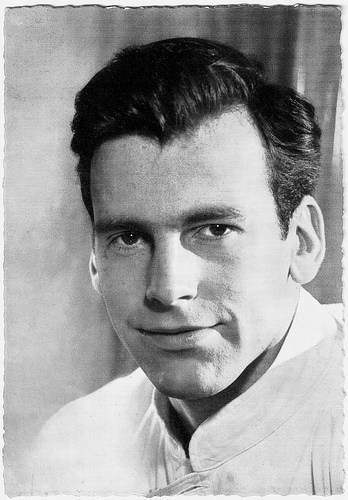
German postcard by WS-Druck, Wanne-Eickel, no. 241. Photo: Real-Film.
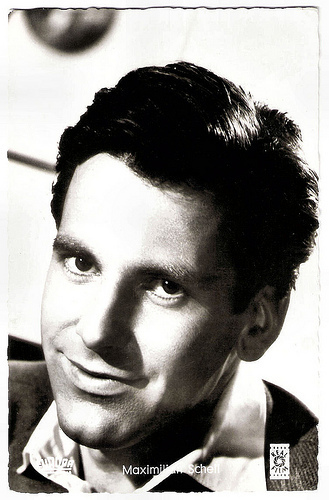
German postcard by Kolibri-Verlag, Minden/Westf.no. 2275. Photo: Real / Europa / Gabriele. Publicity still for Ein Herz kehrt heim/A Heart returns home (Eugen York, 1956).
Sources: Sandra Brennan (AllMovie), (IMDb), Connor McMadden (AllMovie), Filmportal.de, Wikipedia, and .

Belgian postcard by Cox, no. 7.

German postcard by Kolibri-Verlag G.m.b.H, Minden-Westf., no. 2445. Photo: Arthur Grimm / CCC / Constantin. Publicity still for Die Letzten werden die Ersten sein/The Last Ones Shall Be First (Rolf Hansen, 1957).
An Accidental Hollywood Career
Maximilian Schell was born in Vienna, Austria in 1930. He was the son of Margarethe Schell née Noe von Nordberg, an actress who ran an acting school, and Hermann Ferdinand Schell, a Swiss poet, novelist, playwright, and owner of a pharmacy. Schell's late elder sister, Maria Schell, was also an actress; as are their two other siblings, Carl and Immy (Immaculata) Schell. When Austria became part of Nazi-Germany after the ‘anschluss’ of 1938, the Schell family moved to Zurich, Switzerland. Maximilian's interest in acting began at early age. When 11, he appeared in a professional production of William Tell and in the same year he wrote a play which was produced by his school. Later he served in the Swiss Army, achieving the rank of corporal. In 1952, he began acting at the Basel Theatre. He played a small role as a desperate deserter in the war film Kinder, Mütter und ein General/Children, Mother, and the General (László Benedek, 1955) starring Hilde Krahl. That year he also played parts in Der 20. Juli/The Plot to Assassinate Hitler (Falk Harnack, 1955), Reifende Jugend/Ripening Youth (Ulrich Erfurth, 1955) and Ein Mädchen aus Flandern/The Girl from Flanders (Helmut Käutner, 1956) with Nicole Berger. His breakthrough in the cinema was the German crime film Die Letzten werden die Ersten sein/The Last Ones Shall Be First (Rolf Hansen, 1957). The film, which starred O.E. Hasse and Ulla Jacobsson, was entered into the 7th Berlin International Film Festival. Schell made his Hollywood debut as a Nazi officer in the World War II film The Young Lions (Edward Dmytryk, 1958) starring Marlon Brando and Montgomery Clift. According to Jon C. Hopwood at IMDb “quite by accident, as the producers had wanted to hire his sister Maria Schell, but lines of communication got crossed, and he was the one hired.” He stayed in America and in 1959, he appeared as Hans Rolfe, an enigmatic defense attorney, in a live Playhouse 90 television production of Judgment at Nuremberg (George Roy Hill, 1959). In 1961, Schell reprised the role for the big screen remake Judgement at Nuremberg (Stanley Kramer, 1961) with an all star cast including Spencer Tracy, Burt Lancaster, and Marlene Dietrich. As the first German speaking actor after World War II, Schell won the Academy Award for Best Actor. He also won a Golden Globe and the New York Film Critics Circle Award for the role. In the following years, Schell starred in international productions like the Italian-French drama I sequestrati di Altona/The Condemned of Altona (Vittorio De Sica, 1962) opposite Sophia Loren, the heist film Topkapi (Jules Dassin, 1964) with Melina Mercouri, the British drama Return from the Ashes (J. Lee Thompson, 1965) with Ingrid Thulin, and the British espionage–thriller The Deadly Affair (Sidney Lumet, 1966) based on John le Carré's first novel Call for the Dead. In Hollywood, he was often top billed in Third Reich themed films, such as Counterpoint (Ralph Nelson, 1968), The Man in the Glass Booth (Arthur Hiller, 1975) – a role for which he was nominated for an Academy Award, Cross of Iron (Sam Peckinpah, 1977), Julia (Fred Zinnemann, 1977) – for which he got another Oscar nomination, and A Bridge Too Far (Richard Attenborough, 1977). However, he also played in various films with different subjects, including the historical disaster film Krakatoa, East of Java (Bernard L. Kowalski, 1969), the science fiction film The Black Hole (Gary Nelson, 1979), and the crime comedy The Freshman (Andrew Bergman, 1990) starring Marlon Brando and Matthew Broderick.

German postcard by Rüdel-Verlag, Hamburg-Bergedorf., no. 1868. Photo: Gabriele / Real / Europa. Publicity still for Ein Herz kehrt heim/A Heart Goes Home (Eugen York, 1956).

German postcard by Kunst und Bild, Berlin-Charlottenburg, no. V 128. Photo: CCC / Constantin / Arthur Grimm. Publicity still for Die Letzten werden die Ersten sein/The Last Ones Shall Be First (Rolf Hansen, 1957).

German postcard by Friedr. W. Sander-Verlag, Minden/Kolbri-Karte, no. 2005. Photo: 20th Century Fox. Publicity still for Judgment at Nuremberg (Stanley Kramer, 1961).
Marlene and Maria
Maximilian Schell has also served as a writer, producer and director for a variety of films. In 1968, Schell produced and starred in the adaptation of Kafka's novel Das Schloss/The Castle. Two years later, Erste Liebe/First Love (1970) - written, directed, produced, and starred in by Schell - was hailed by the critics. His Der Fußgänger/The Pedestrian (1974), in which he also starred, was nominated for the Oscar for Best Foreign Language Film and won a Golden Globe. His documentary on Marlene Dietrich, Marlene (1984) was based on the audio tape recordings of his 17-hours-long interview session with Dietrich. Using original footage, documentary material and interview passages, he managed to present an intimate portrait of her, which won also several awards. 18 years later, he made a documentary about his late sister Maria Schell, Meine Schwester Maria/My Sister Maria (2002). Connor McMadden at AllMovie : "Using excerpts of her feature films along with home movie footage, Schell explores the high points his sister's career throughout the 1950s, as well as the personal problems that cast her into obscurity only a decade later. The film offers quite a few emotional peaks, especially when an elderly Maria Schell goes before her brother's camera to speak candidly about her life, and a suicide attempt which she refers to as her 'first death.'" In addition to his film career, Maximilian Schell has also been active as director, writer and actor in the European theatre. In 1958, he made his Broadway debut in Ira Levin’s Interlock. In 1965, he starred in John Osborne’s groundbreaking A Patriot for Me, first at London’s Royal Court Theatre and later on Broadway. He has twice played Hamlet on stage, originally under the direction of the legendary Gustaf Grundgens and later under his own direction. In 1972 he starred in Peter Hall's German language première of Harold Pinter's Old Times at the Burgtheater in Vienna. In 1977 he directed Tales from the Vienna Woods at the National Theatre in London. In later life he also began directing operatic productions, starting with Giuseppe Verdi's La Traviata. This passion was triggered when he was performing in the play Jedermann (Everyman) in Salzburg, Austria from 1978-1982, and he came into contact with several musical conductors including Leonard Bernstein, James Levine and Claudio Abbado. In 2006 he appeared in Arthur Miller's Resurrection Blues directed by Robert Altman at the Old Vic in London. He also often appeared on television, such as in the miniseries Peter the Great (Marvin J. Chomsky, Lawrence Schiller, 1986), with Vanessa Redgrave and Laurence Olivier. He was twice been nominated for an Emmy for his TV work, and in 1993, he won a Golden Globe for his part as Vladimir Lenin in the HBO miniseries Stalin (Ivan Passer, 1992). In 1990, he had refused to receive the Honorary German Film Award because he felt too young to be awarded with an award for lifetime achievement. For German television, he played in the television miniseries The Return of the Dancing Master (Urs Egger, 2004), which was based on Henning Mankell's crime novel. Through the decades he continued to star in international film productions, such as The Rose Garden (Fons Rademakers, 1986), Left Luggage (Jeroen Krabbé, 1998), Deep Impact (Mimi Leder, 1998), Vampires (John Carpenter, 1998), and the American comedy The Brothers Bloom (Rian Johnson, 2008) with Adrien Brody and Mark Ruffalo. At IMDb, Jon C. Hopwood writes: “with the exception of Maurice Chevalier and Marcello Mastroianni, Schell is undoubtedly the most successful non-Anglophone foreign actor in the history of American cinema.” Maximilian Schell was married to actress Natalya Andreychenko (1985-2005). Their daughter is actress Nastassja Schell (born in 1989). He is also the godfather of actress Angelina Jolie. This year, Maximilian Schell can be seen in two new films, Les brigands (Pol Cruchten, Frank Hoffmann, 2013) opposite Tchéky Karyo, and An Artist's Emblem (Michael J. Narvaez, 2013) with Harry Dean Stanton.

German postcard by WS-Druck, Wanne-Eickel, no. 241. Photo: Real-Film.

German postcard by Kolibri-Verlag, Minden/Westf.no. 2275. Photo: Real / Europa / Gabriele. Publicity still for Ein Herz kehrt heim/A Heart returns home (Eugen York, 1956).
Sources: Sandra Brennan (AllMovie), (IMDb), Connor McMadden (AllMovie), Filmportal.de, Wikipedia, and .
Published on July 19, 2013 23:00
Paul van Yperen's Blog
- Paul van Yperen's profile
- 13 followers
Paul van Yperen isn't a Goodreads Author
(yet),
but they
do have a blog,
so here are some recent posts imported from
their feed.



